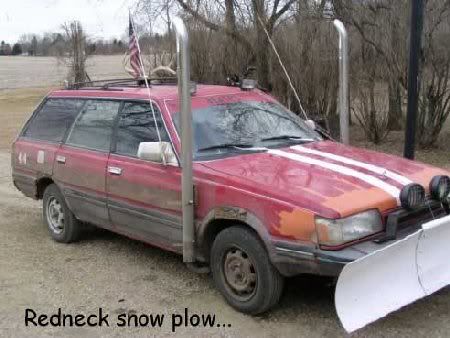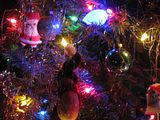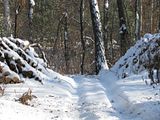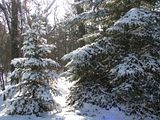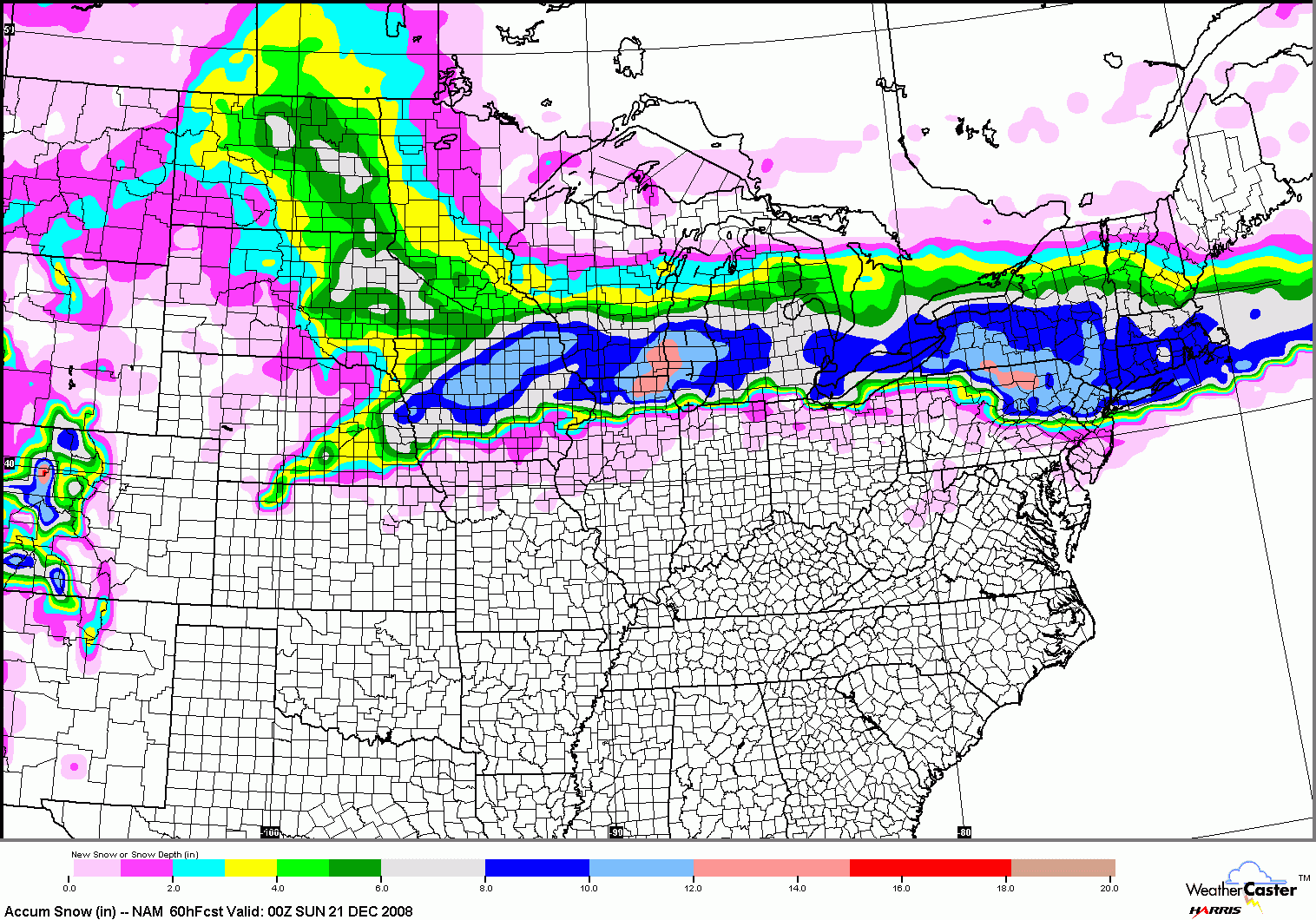News From The Observatory
-4°F this morning. Another 4" of snow yesterday/last night.
I don't mind the cold weather, I prefer it actually, but snow sucks. It's way more work than it's worth, and it keeps me from doing what I want to do most, cut firewood.
I haven't had the observatory equipment out lately. The weather has been too harsh. They say it won't hurt anything, but I don't want to push my camera and telescope too hard. The stargazing I have done has been with my eyes and binoculars. Just as fun, sometimes more fun, and certainly quicker and easier on a below zero night!
Might go for an ATV ride on Sunday, depending on the weather. Cold is ok, but if we get a storm I won't be driving the old bald-tired truck anywhere! I've been riding the '96 Polaris Trailboss down to the barn lately. It doesn't get much use these days and I thought it would do it good to run it a little. The battery is no good, it won't take a charge, so I'll have to get a new one next time I get to town. And since the battery won't take a charge, it burned the bulbs out like it always does when that happens. I'll have to get new headlight and taillight bulbs for it too.
- Quads, hailing from Grand Marsh Observatory atop Elk Castle Hill
Wednesday, December 31, 2008
The evening sky bids farewell to the old year tonight with a beautiful display: a close pairing of the crescent Moon and the planet Venus. Venus is the brilliant "evening star" a little below or to the lower left of the Moon as they pop into view.
- Quads, hailing from Grand Marsh Observatory atop Elk Castle Hill
- Quads, hailing from Grand Marsh Observatory atop Elk Castle Hill
Top 5 Amazing Astronomy Discoveries in 2008
Astronomers have continued to cast their eyes to the heavens, with bigger and better telescopes and as much passion as ever this year, but some of the coolest findings of 2008 were right in our own backyard, or at least looked like they were.
From worlds nearby like Mercury and Mars to those beyond our solar system, planetary science saw a boon. As for extrasolar planets, astronomers bagged at least 50 newbies this year.
"It's been a very exciting year for exoplanet discoveries," said Michael Liu, an astronomer at the University of Hawaii.
What's responsible for the surge of exoplanet detections?
"The big picture is that a wide variety of new technologies, both instruments on existing telescopes and new dedicated telescopes, are really allowing astronomers to do much more sensitive measurements, and thus leading to a real bonanza of discoveries," Liu told SPACE.com.
And there's more. Here are five favorite findings in astronomy for 2008:
1. Alien worlds
With the extrasolar planet tally now well above 300, astronomers seem to be on track for spotting another Earth (the astronomical jackpot) before long. Along the way this year, a jaw-dropping announcement came in November when two teams of astronomers reported they had snapped direct images of exoplanets.
Geoffrey Marcy of the University of California, Berkeley, calls the images "the most spectacular thing in 2008."
"In my own professional opinion this is by far the most definitive picture of a planet ever taken," Marcy said during a telephone interview, referring to the direct image by the Hubble Space Telescope of the planet called Fomalhaut b.
The gold rush of exoplanet discoveries this year boils down to new techniques and observatories as well as energetic astronomers involved, Marcy said.
Some other highlights include: the least-massive planet, weighing in at just three times the mass of Earth; the hottest planet, with temperatures reaching about 4,000 degrees Fahrenheit (2,200 degrees Celsius); and three so-called super-Earths orbiting a star.
Astronomers like Marcy predict the upcoming year will bring us even closer to detecting Earth's twin. For instance, NASA's Kepler mission is scheduled to launch in March with the goal of finding rocky planets about the size of Earth that orbit within the habitable zone of their host stars where liquid water and life might exist. Stay tuned.
2. Martian life?
The red planet has gotten celebrity treatment this past year, with the touchdown of NASA's Phoenix Mars Lander in May, the continuing presence of the Mars Exploration Rover twins (Spirit and Opportunity) and NASA's Mars Reconnaissance Orbiter (which has imaged nearly 40 percent of the planet).
A major goal of such missions has been to find signs of past or present liquid water, the main ingredient for life. That's why Phoenix snagged a star-studded headline when the lander collected water ice near Mars' north pole this year.
Earlier in the year, Spirit found deposits of silica in Gusev Crater, suggesting, scientists said, that hot water once flowed through the Martian soil in hydrothermal vents. As on Earth, these hydrothermal vents may have once harbored life. The discovered silica could preserve fossils of such ancient life if it did indeed exist there.
And just in from MRO — evidence of carbonates on the Martian surface. Since carbonates can't survive in acidic, harsh conditions, the mineral finding suggests any microbes crawling around when Mars was wet could've enjoyed a cushy existence.
3. Dark energy
Scientists were hot on the trail this year of a mysterious "force" called dark energy that has been expanding the universe at an increasing pace and was only discovered about 10 years ago.
Though, admittedly, scientists say they are more than a few years away from solving the puzzler of what dark energy is, a new method this year confirmed its existence, suggesting the force is stifling the growth of galaxies in the universe. Basically, in an expanding universe dominated by dark energy, galaxies fly away from one another rather than mingle and merge.
These results also suggest dark energy takes the form of what Einstein called the cosmological constant — a term in Einstein's theory of general relativity that represents the possibility of empty space having a density and pressure associated with it.
4. Black hole antics
Black holes are so dense that nothing, not even light, can escape their gravitational grips. Though invisible, astronomers have inferred the presence of the dark behemoths from their effects on nearby objects. And this year, it seems, all the crazies came out of their cosmic closets.
Take the fastest spinning black hole, found to whirl around at speeds approaching the speed of light.
And when it comes to obesity, one black hole could've gobbled up 18 billion suns. This giant would dwarf the smallest black hole found this year, weighing in at about 3.8 times the mass of our sun and spanning just 15 miles (24 km) in diameter.
Researchers also found this year that some supermassive black holes, which reside at the centers of many or all galaxies, spew out giant bubbles from the tips of their jets. (As material falls into the gravitational clutches of a black hole, the energy can be spit out as jets of radiation and high-speed particles.) The bubbles ultimately pop, spilling their gaseous guts. Turns out, the hot gas keeps the black hole and its galaxy from ballooning to mega sizes.
Black holes can also take the form of "masked fugitive." Computer simulations revealed that when two black holes merge, the energy produced can kick the newly merged black hole clear out of its galaxy.
Also, for the first time this year, scientists detected such a rogue black hole racing along at 5,900,000 mph (2,650 kilometers per second).
5. Solving Mercury mysteries
More than half of our solar system's smallest planet (Pluto once took this honor), Mercury, had remained a mystery until this year. On Jan. 14, NASA's MESSENGER probe made its first flyby of Mercury, beginning a mission to image the entire planet.
From the get-go, the probe sent back intriguing images, including clear evidence for volcanoes. Images of the Caloris basin showed hints of lava flows and the presence of a shield volcano larger than the state of Delaware, with gently sloping sides.
And Mercury is indeed shrinking as its iron-rich core slowly cools. Scientists had speculated this much from images taken during the Mariner 10 mission in 1974. But MESSENGER images showed more faults than did Mariner 10, suggesting the strain from the planet's contraction was at least one-third greater than originally thought.
More to come: The thousands of images and other data collected by MESSENGER could also shed light on other Mercury mysteries, including the planet's relatively giant core, which makes up about two-thirds of the planet's mass. One idea is that huge impacts hundreds of millions of years ago might have stripped the innermost planet of its original surface.
source....
Astronomers have continued to cast their eyes to the heavens, with bigger and better telescopes and as much passion as ever this year, but some of the coolest findings of 2008 were right in our own backyard, or at least looked like they were.
From worlds nearby like Mercury and Mars to those beyond our solar system, planetary science saw a boon. As for extrasolar planets, astronomers bagged at least 50 newbies this year.
"It's been a very exciting year for exoplanet discoveries," said Michael Liu, an astronomer at the University of Hawaii.
What's responsible for the surge of exoplanet detections?
"The big picture is that a wide variety of new technologies, both instruments on existing telescopes and new dedicated telescopes, are really allowing astronomers to do much more sensitive measurements, and thus leading to a real bonanza of discoveries," Liu told SPACE.com.
And there's more. Here are five favorite findings in astronomy for 2008:
1. Alien worlds
With the extrasolar planet tally now well above 300, astronomers seem to be on track for spotting another Earth (the astronomical jackpot) before long. Along the way this year, a jaw-dropping announcement came in November when two teams of astronomers reported they had snapped direct images of exoplanets.
Geoffrey Marcy of the University of California, Berkeley, calls the images "the most spectacular thing in 2008."
"In my own professional opinion this is by far the most definitive picture of a planet ever taken," Marcy said during a telephone interview, referring to the direct image by the Hubble Space Telescope of the planet called Fomalhaut b.
The gold rush of exoplanet discoveries this year boils down to new techniques and observatories as well as energetic astronomers involved, Marcy said.
Some other highlights include: the least-massive planet, weighing in at just three times the mass of Earth; the hottest planet, with temperatures reaching about 4,000 degrees Fahrenheit (2,200 degrees Celsius); and three so-called super-Earths orbiting a star.
Astronomers like Marcy predict the upcoming year will bring us even closer to detecting Earth's twin. For instance, NASA's Kepler mission is scheduled to launch in March with the goal of finding rocky planets about the size of Earth that orbit within the habitable zone of their host stars where liquid water and life might exist. Stay tuned.
2. Martian life?
The red planet has gotten celebrity treatment this past year, with the touchdown of NASA's Phoenix Mars Lander in May, the continuing presence of the Mars Exploration Rover twins (Spirit and Opportunity) and NASA's Mars Reconnaissance Orbiter (which has imaged nearly 40 percent of the planet).
A major goal of such missions has been to find signs of past or present liquid water, the main ingredient for life. That's why Phoenix snagged a star-studded headline when the lander collected water ice near Mars' north pole this year.
Earlier in the year, Spirit found deposits of silica in Gusev Crater, suggesting, scientists said, that hot water once flowed through the Martian soil in hydrothermal vents. As on Earth, these hydrothermal vents may have once harbored life. The discovered silica could preserve fossils of such ancient life if it did indeed exist there.
And just in from MRO — evidence of carbonates on the Martian surface. Since carbonates can't survive in acidic, harsh conditions, the mineral finding suggests any microbes crawling around when Mars was wet could've enjoyed a cushy existence.
3. Dark energy
Scientists were hot on the trail this year of a mysterious "force" called dark energy that has been expanding the universe at an increasing pace and was only discovered about 10 years ago.
Though, admittedly, scientists say they are more than a few years away from solving the puzzler of what dark energy is, a new method this year confirmed its existence, suggesting the force is stifling the growth of galaxies in the universe. Basically, in an expanding universe dominated by dark energy, galaxies fly away from one another rather than mingle and merge.
These results also suggest dark energy takes the form of what Einstein called the cosmological constant — a term in Einstein's theory of general relativity that represents the possibility of empty space having a density and pressure associated with it.
4. Black hole antics
Black holes are so dense that nothing, not even light, can escape their gravitational grips. Though invisible, astronomers have inferred the presence of the dark behemoths from their effects on nearby objects. And this year, it seems, all the crazies came out of their cosmic closets.
Take the fastest spinning black hole, found to whirl around at speeds approaching the speed of light.
And when it comes to obesity, one black hole could've gobbled up 18 billion suns. This giant would dwarf the smallest black hole found this year, weighing in at about 3.8 times the mass of our sun and spanning just 15 miles (24 km) in diameter.
Researchers also found this year that some supermassive black holes, which reside at the centers of many or all galaxies, spew out giant bubbles from the tips of their jets. (As material falls into the gravitational clutches of a black hole, the energy can be spit out as jets of radiation and high-speed particles.) The bubbles ultimately pop, spilling their gaseous guts. Turns out, the hot gas keeps the black hole and its galaxy from ballooning to mega sizes.
Black holes can also take the form of "masked fugitive." Computer simulations revealed that when two black holes merge, the energy produced can kick the newly merged black hole clear out of its galaxy.
Also, for the first time this year, scientists detected such a rogue black hole racing along at 5,900,000 mph (2,650 kilometers per second).
5. Solving Mercury mysteries
More than half of our solar system's smallest planet (Pluto once took this honor), Mercury, had remained a mystery until this year. On Jan. 14, NASA's MESSENGER probe made its first flyby of Mercury, beginning a mission to image the entire planet.
From the get-go, the probe sent back intriguing images, including clear evidence for volcanoes. Images of the Caloris basin showed hints of lava flows and the presence of a shield volcano larger than the state of Delaware, with gently sloping sides.
And Mercury is indeed shrinking as its iron-rich core slowly cools. Scientists had speculated this much from images taken during the Mariner 10 mission in 1974. But MESSENGER images showed more faults than did Mariner 10, suggesting the strain from the planet's contraction was at least one-third greater than originally thought.
More to come: The thousands of images and other data collected by MESSENGER could also shed light on other Mercury mysteries, including the planet's relatively giant core, which makes up about two-thirds of the planet's mass. One idea is that huge impacts hundreds of millions of years ago might have stripped the innermost planet of its original surface.
source....
Tuesday, December 30, 2008
A BLONDE WINTER
As a trucker stops for a red light, a blonde catches up.
She jumps out of her car, runs up to his truck, and knocks
on the door.
The trucker lowers the window, and she says "Hi, my
name is Heather and you are losing some of your load."
The trucker ignores her and proceeds down the street.
When the truck stops for another red light, the girl
catches up again.
She jumps out of her car, runs up and knocks on the door.
Again, the trucker lowers the window. As if they've
never spoken, the blonde says brightly, "Hi my name is
Heather, and you are losing some of your load!"
Shaking his head, the trucker ignores her again and
continues down the street.
At the third red light, the same thing happens again.
All out of breath, the blonde gets out of her car, runs
up, knocks on the truck door. The trucker rolls down the
window.
Again she says "Hi, my name is Heather, and you are
losing some of your load!"
When the light turns green the trucker revs up and races to
the next light.
When he stops this time, he hurriedly gets out of the
truck, and runs back to the blonde.
He knocks on her window, and after she lowers it, he
says...
"Hi, my name is Mark, it's winter in Wisconsin,
and I'm driving the SALT TRUCK!"
Thanks Rich!
- Quads, hailing from Grand Marsh Observatory atop Elk Castle Hill
As a trucker stops for a red light, a blonde catches up.
She jumps out of her car, runs up to his truck, and knocks
on the door.
The trucker lowers the window, and she says "Hi, my
name is Heather and you are losing some of your load."
The trucker ignores her and proceeds down the street.
When the truck stops for another red light, the girl
catches up again.
She jumps out of her car, runs up and knocks on the door.
Again, the trucker lowers the window. As if they've
never spoken, the blonde says brightly, "Hi my name is
Heather, and you are losing some of your load!"
Shaking his head, the trucker ignores her again and
continues down the street.
At the third red light, the same thing happens again.
All out of breath, the blonde gets out of her car, runs
up, knocks on the truck door. The trucker rolls down the
window.
Again she says "Hi, my name is Heather, and you are
losing some of your load!"
When the light turns green the trucker revs up and races to
the next light.
When he stops this time, he hurriedly gets out of the
truck, and runs back to the blonde.
He knocks on her window, and after she lowers it, he
says...
"Hi, my name is Mark, it's winter in Wisconsin,
and I'm driving the SALT TRUCK!"
Thanks Rich!
- Quads, hailing from Grand Marsh Observatory atop Elk Castle Hill
UFO Year in Review
In a 4-hour special on Coast to Coast AM, George Knapp welcomed Alejandro Rojas and James Carrion, both of MUFON to review UFO sightings and events of 2008. They were joined by special guests throughout the evening. Rojas said it was a wonderful year for media coverage, with the UFO subject being covered both more extensively, and seriously. Carrion noted that one continuing obstacle is government involvement-- they may be using the UFO field as a convenient cover for their own testing of exotic weapons, or psychological warfare experiments.
MUFON believes the California Drones were a hoax, partially because all of the witnesses chose to remain anonymous, Carrion commented. The drones recently surfaced in the plot of the TV show, Terminator: Sarah Conner Chronicles, and Carrion said he spoke with one of the producers' who said they took the images off the Internet, rather than creating them on their own. One of the strongest pieces of evidence this year was the radar data retrieved from the Stephenville incidents on January 8th, which correlated with the sightings, and indicated an unknown object was heading toward the Crawford Ranch, said Carrion. Reporter Angelia Joiner appearing for a segment, noted that many F-16s were in the area during this sighting, and the fact that they paid no attention to the UFO, indicates they already knew what it was.
UFO researcher Stanton Friedman discussed the continued efforts of debunkers to besmirch ufology even though they know little about the field, including two professors at Florida State University at Tallahassee, who referred to Friedman as a "pseudo-scientist" after he lectured at the college. Author William Birnes spoke about the sea change in media coverage of UFO stories, including the Peckman/Romanek alien video. Activist Stephen Bassett suggested this past year was an extremely important one for UFO disclosure, with the release of declassified documents in foreign countries, and Obama's selections for his administration, including John Podesta, an advocate for ending UFO secrecy. Frank Costigan, a witness of the Needles UFO crash, also appeared with an update.
source....
In a 4-hour special on Coast to Coast AM, George Knapp welcomed Alejandro Rojas and James Carrion, both of MUFON to review UFO sightings and events of 2008. They were joined by special guests throughout the evening. Rojas said it was a wonderful year for media coverage, with the UFO subject being covered both more extensively, and seriously. Carrion noted that one continuing obstacle is government involvement-- they may be using the UFO field as a convenient cover for their own testing of exotic weapons, or psychological warfare experiments.
MUFON believes the California Drones were a hoax, partially because all of the witnesses chose to remain anonymous, Carrion commented. The drones recently surfaced in the plot of the TV show, Terminator: Sarah Conner Chronicles, and Carrion said he spoke with one of the producers' who said they took the images off the Internet, rather than creating them on their own. One of the strongest pieces of evidence this year was the radar data retrieved from the Stephenville incidents on January 8th, which correlated with the sightings, and indicated an unknown object was heading toward the Crawford Ranch, said Carrion. Reporter Angelia Joiner appearing for a segment, noted that many F-16s were in the area during this sighting, and the fact that they paid no attention to the UFO, indicates they already knew what it was.
UFO researcher Stanton Friedman discussed the continued efforts of debunkers to besmirch ufology even though they know little about the field, including two professors at Florida State University at Tallahassee, who referred to Friedman as a "pseudo-scientist" after he lectured at the college. Author William Birnes spoke about the sea change in media coverage of UFO stories, including the Peckman/Romanek alien video. Activist Stephen Bassett suggested this past year was an extremely important one for UFO disclosure, with the release of declassified documents in foreign countries, and Obama's selections for his administration, including John Podesta, an advocate for ending UFO secrecy. Frank Costigan, a witness of the Needles UFO crash, also appeared with an update.
source....
Monday, December 29, 2008
Sunday, December 28, 2008
Orion and Taurus are in great view right now. They are in the southeast at nightfall. Look for Orion's Belt, which is a short line of three bright stars. Taurus is above Orion, marked by its V-shaped face and its orange eye, represented by the star Aldebaran.
- Quads, hailing from Grand Marsh Observatory atop Elk Castle Hill
- Quads, hailing from Grand Marsh Observatory atop Elk Castle Hill
Saturday, December 27, 2008
With Christmas night's overnight snowfall, Juneau County has now experienced a record amount of snow for December. Slightly over 32-inches of snow has fallen since the first of the month...exceeded the old mark by an 1 1/2 set in 2000. La Crosse and other nearby cities have also experienced a record amount of the white stuff. It's also one of the coldest Decembers on record, with the average temperature for the month in the coldest eight on record.
- Quads, hailing from Grand Marsh Observatory atop Elk Castle Hill
- Quads, hailing from Grand Marsh Observatory atop Elk Castle Hill
Saturn's Crazy Christmas Tilt
You look through the telescope. Blink. Shake your head and look again. The planet you expected to see in the eyepiece is not the one that's actually there. Too much eggnog?
No, it's just Saturn's crazy Christmas tilt.
All year long, the rings of Saturn have been tilting toward Earth and now they are almost perfectly edge-on. The opening angle is a paper-thin 0.8o. Viewed from the side, the normally wide and bright rings have become a shadowy line bisecting Saturn's two hemispheres--a scene of rare beauty.
Amateur astronomer Efrain Morales Rivera of Aguadilla, Puerto Rico, has been monitoring Saturn and he created this composite image to show how the geometry has changed:
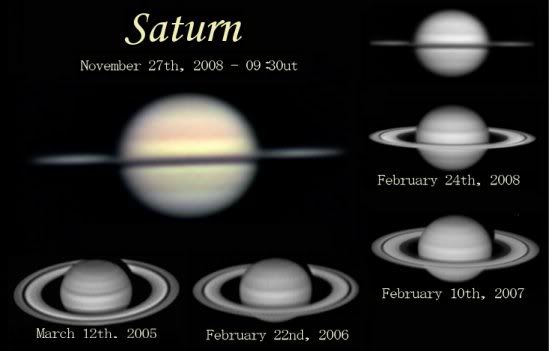
Astronomers call the phenomenon a "ring plane crossing." As Saturn goes around the sun, it periodically (once every 14 to 15 years) turns its rings edge-on to Earth. Because the rings are so thin, they can actually disappear when viewed through a backyard telescope. At the precise moment of crossing, Saturn undergoes a startling metamorphosis. The ringed planet becomes a lonely ball of gas, almost unrecognizable.
(Historical note: Shortly after Galileo discovered Saturn's rings in 1610, they disappeared in precisely this fashion. Galileo didn't understand the nature of the rings and the vanishing act confused him mightily. Nevertheless, his physical intuition prevailed. "They'll be back," he predicted, and without ever knowing why, he was correct.)
We're not quite there yet. The opening angle won't be precisely 0o until Sept. 4, 2009. Don't bother marking your calendar, though. Saturn will be so close to the sun, no one will be able to see the rings wink out.
The best time to look is now.
The 0.8o opening angle of Christmas 2008 is the minimum for some time to come. In January 2009 the rings begin to open up again, a temporary reversal caused by the orbital motions of Earth and Saturn. By the time narrowing resumes in summer 2009, Saturn will be approaching the sun; looking through a telescope then could actually be dangerous. The next ring plane crossing that's easy to watch won't come until 2038.
So wake up before sunrise, point your telescope at the golden "star" in Leo, and behold Saturn's crazy Christmas tilt.
source....
You look through the telescope. Blink. Shake your head and look again. The planet you expected to see in the eyepiece is not the one that's actually there. Too much eggnog?
No, it's just Saturn's crazy Christmas tilt.
All year long, the rings of Saturn have been tilting toward Earth and now they are almost perfectly edge-on. The opening angle is a paper-thin 0.8o. Viewed from the side, the normally wide and bright rings have become a shadowy line bisecting Saturn's two hemispheres--a scene of rare beauty.
Amateur astronomer Efrain Morales Rivera of Aguadilla, Puerto Rico, has been monitoring Saturn and he created this composite image to show how the geometry has changed:

Astronomers call the phenomenon a "ring plane crossing." As Saturn goes around the sun, it periodically (once every 14 to 15 years) turns its rings edge-on to Earth. Because the rings are so thin, they can actually disappear when viewed through a backyard telescope. At the precise moment of crossing, Saturn undergoes a startling metamorphosis. The ringed planet becomes a lonely ball of gas, almost unrecognizable.
(Historical note: Shortly after Galileo discovered Saturn's rings in 1610, they disappeared in precisely this fashion. Galileo didn't understand the nature of the rings and the vanishing act confused him mightily. Nevertheless, his physical intuition prevailed. "They'll be back," he predicted, and without ever knowing why, he was correct.)
We're not quite there yet. The opening angle won't be precisely 0o until Sept. 4, 2009. Don't bother marking your calendar, though. Saturn will be so close to the sun, no one will be able to see the rings wink out.
The best time to look is now.
The 0.8o opening angle of Christmas 2008 is the minimum for some time to come. In January 2009 the rings begin to open up again, a temporary reversal caused by the orbital motions of Earth and Saturn. By the time narrowing resumes in summer 2009, Saturn will be approaching the sun; looking through a telescope then could actually be dangerous. The next ring plane crossing that's easy to watch won't come until 2038.
So wake up before sunrise, point your telescope at the golden "star" in Leo, and behold Saturn's crazy Christmas tilt.
source....
Friday, December 26, 2008
Thursday, December 25, 2008
Star of wonder
A comet, an eclipse, a supernova, an alignment of planets - was the Star of Bethlehem, said to have led the wise men to the Baby Jesus, a real astronomical event?
Some 2,000 years ago, wise men saw an incredible star shining over the Holy Land. It was their signal to embark on an epic journey to visit the new Messiah. But what exactly was the Star of Bethlehem?
Modern science is unravelling the mystery behind one of the most famous astronomical stories in history. New developments in technology allow astronomers to map the ancient night skies with extraordinary accuracy.
As they study the movements of the planets and stars, experts are challenging the traditional assumption that it was a blazing comet - instead there are several unusual astronomical events that the wise men could have seen in the skies.
The Bible tells us remarkably little about the star, with only the Gospel of St Matthew mentioning it. He records the wise men asking: "Where is he who has been born King of the Jews? For we have seen his star in the east and have come to worship him."
No date or detailed description is given. Even the identity of the men is obscure. Rather than the kings of popular imagination, the wise men are thought to have been priests from Persia, known as Magi. Keen astrologers who looked to the stars for guidance, the Magi combined science with faith to predict the birth of a new Messiah.
So what prompted them to travel to Bethlehem? Most experts agree Jesus was born in 4BC or earlier, as King Herod, who ruled over Judea at the time, is recorded as dying in 4BC. Now astronomers have identified four celestial events in this period that could have been the Star of Bethlehem.
An ancient clay tablet, now in the British Museum, is a key part of one theory which says the star was a rare series of planetary meetings, known as a triple conjunction.
This happened between Jupiter and Saturn and occurred in the night sky in 7BC, says Dr David Hughes, emeritus professor of astronomy at the University of Sheffield.
Jupiter, the royal star, and Saturn came together three times over several months. Significantly, this happened during the constellation of Pisces, a sign associated with Israel.
There is evidence on the clay tablet that Persian astronomers predicted this. The tablet calculates solar, lunar and planetary activity for that year, and describes the conjunctions.
A 2,000-year-old coin, minted north of Judea, is part of the evidence behind another theory. Dr Mike Molnar of Rutgers University, New Jersey, believes the star could have been an occultation, or eclipse, of the moon with Jupiter on 17 April 6BC.
He argues the Magi saw the star in the constellation of Aries, not Pisces. The coin depicts Aries the ram leaping across the sky and looking back at a star.
According to astrological texts from the time, Aries ruled over Judea, with Jerusalem as the capital of the Near East, making it the sign of the Jews.
Dr Molnar believes the Magi saw this eclipse. Just before sunrise, Jupiter would have risen in the east, just as St Matthew describes their sighting of the Star. Then, as the moon passed directly between Earth and Jupiter, the kingmaker planet was hidden from view.
Some think the star could have been a much bigger celestial event. European Space Agency astronomer Dr Mark Kidger believes it would have taken more than unusual planetary movements to persuade such seasoned astronomical experts to travel to Judea.
The Magi could have seen a star entering its supernova phase, one of the most energetic and explosive events known to astronomers.
He has even identified a candidate - DO Aquilae - which erupted in 1927 and is likely to have erupted several times previously. If it had erupted 2,000 years ago, the Magi would have seen it just above the horizon, in the east.
He hopes radio telescopes in the future will be able to detect a faint bubble of expanding gas around Aquilae and calculate when exactly the bubble started to expand.
One theory has the most surprising twist. The date for celebrating Christmas was only fixed centuries after the event - and is questioned by many - but Texan law professor and astronomer Rick Larson believes Jesus really could have been born on 25 December. But on 25 December 2BC.
Unlike other astronomers, he has looked at later celestial events because he thinks the calculation of King Herod's death is inaccurate. The 4BC date is based on the writings of the historian Josephus, but every Josephus manuscript he has studied dating before 1544 is consistent with Herod having died in 1BC.
In 2BC Jupiter met up with one of the brightest stars in the sky, Regulus, known by the Magi as the "little king". Nine months later, Jupiter met Venus, known as the mother planet. These meetings would have been symbolically significant, as was the timescale involved.
The planets would have seemed so close they would have looked like one bright light in the sky. Professor Larson believes this light was what prompted the Magi to travel to the east. As they made their way, Jupiter continued to move across the sky until it appeared to stand still over Bethlehem.
source....
A comet, an eclipse, a supernova, an alignment of planets - was the Star of Bethlehem, said to have led the wise men to the Baby Jesus, a real astronomical event?
Some 2,000 years ago, wise men saw an incredible star shining over the Holy Land. It was their signal to embark on an epic journey to visit the new Messiah. But what exactly was the Star of Bethlehem?
Modern science is unravelling the mystery behind one of the most famous astronomical stories in history. New developments in technology allow astronomers to map the ancient night skies with extraordinary accuracy.
As they study the movements of the planets and stars, experts are challenging the traditional assumption that it was a blazing comet - instead there are several unusual astronomical events that the wise men could have seen in the skies.
The Bible tells us remarkably little about the star, with only the Gospel of St Matthew mentioning it. He records the wise men asking: "Where is he who has been born King of the Jews? For we have seen his star in the east and have come to worship him."
No date or detailed description is given. Even the identity of the men is obscure. Rather than the kings of popular imagination, the wise men are thought to have been priests from Persia, known as Magi. Keen astrologers who looked to the stars for guidance, the Magi combined science with faith to predict the birth of a new Messiah.
So what prompted them to travel to Bethlehem? Most experts agree Jesus was born in 4BC or earlier, as King Herod, who ruled over Judea at the time, is recorded as dying in 4BC. Now astronomers have identified four celestial events in this period that could have been the Star of Bethlehem.
An ancient clay tablet, now in the British Museum, is a key part of one theory which says the star was a rare series of planetary meetings, known as a triple conjunction.
This happened between Jupiter and Saturn and occurred in the night sky in 7BC, says Dr David Hughes, emeritus professor of astronomy at the University of Sheffield.
Jupiter, the royal star, and Saturn came together three times over several months. Significantly, this happened during the constellation of Pisces, a sign associated with Israel.
There is evidence on the clay tablet that Persian astronomers predicted this. The tablet calculates solar, lunar and planetary activity for that year, and describes the conjunctions.
A 2,000-year-old coin, minted north of Judea, is part of the evidence behind another theory. Dr Mike Molnar of Rutgers University, New Jersey, believes the star could have been an occultation, or eclipse, of the moon with Jupiter on 17 April 6BC.
He argues the Magi saw the star in the constellation of Aries, not Pisces. The coin depicts Aries the ram leaping across the sky and looking back at a star.
According to astrological texts from the time, Aries ruled over Judea, with Jerusalem as the capital of the Near East, making it the sign of the Jews.
Dr Molnar believes the Magi saw this eclipse. Just before sunrise, Jupiter would have risen in the east, just as St Matthew describes their sighting of the Star. Then, as the moon passed directly between Earth and Jupiter, the kingmaker planet was hidden from view.
Some think the star could have been a much bigger celestial event. European Space Agency astronomer Dr Mark Kidger believes it would have taken more than unusual planetary movements to persuade such seasoned astronomical experts to travel to Judea.
The Magi could have seen a star entering its supernova phase, one of the most energetic and explosive events known to astronomers.
He has even identified a candidate - DO Aquilae - which erupted in 1927 and is likely to have erupted several times previously. If it had erupted 2,000 years ago, the Magi would have seen it just above the horizon, in the east.
He hopes radio telescopes in the future will be able to detect a faint bubble of expanding gas around Aquilae and calculate when exactly the bubble started to expand.
One theory has the most surprising twist. The date for celebrating Christmas was only fixed centuries after the event - and is questioned by many - but Texan law professor and astronomer Rick Larson believes Jesus really could have been born on 25 December. But on 25 December 2BC.
Unlike other astronomers, he has looked at later celestial events because he thinks the calculation of King Herod's death is inaccurate. The 4BC date is based on the writings of the historian Josephus, but every Josephus manuscript he has studied dating before 1544 is consistent with Herod having died in 1BC.
In 2BC Jupiter met up with one of the brightest stars in the sky, Regulus, known by the Magi as the "little king". Nine months later, Jupiter met Venus, known as the mother planet. These meetings would have been symbolically significant, as was the timescale involved.
The planets would have seemed so close they would have looked like one bright light in the sky. Professor Larson believes this light was what prompted the Magi to travel to the east. As they made their way, Jupiter continued to move across the sky until it appeared to stand still over Bethlehem.
source....
The stars offer a fitting holiday decoration early this evening. It is the northern cross, which is also known as Cygnus, the swan. Its brightest stars form the shape of a crucifix, which stands almost straight up from the northwestern horizon as darkness falls.
- Quads, hailing from Grand Marsh Observatory atop Elk Castle Hill
- Quads, hailing from Grand Marsh Observatory atop Elk Castle Hill
Wednesday, December 24, 2008
A spider as big as a dinner plate has been found living in one of the world's last scientifically unexplored regions.
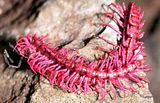
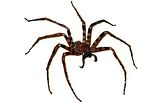
The Greater Mekong, which is made up of 600,000 square kilometres of wetlands and rainforest along the Mekong River in Cambodia, Laos, Burma, Thailand, Vietnam and China, is also home to striped rabbits, bright pink millipedes laced with cyanide and a rat that was believed to have become extinct 11 million years ago.
A huntsman spider, named Heteropoda maxima, measured 30cm across and was found in caves in Laos. It was described as the "most remarkable" of 88 new species of spider located in Laos, Thailand and the Yunnan province of China.
Among the 15 mammals discovered in the region was the Laotian rock rat, Laonastes aenigmamus.
It was thought to have been extinct for 11 million years but a researcher spotted the corpse of one on sale in a food market in Laos in 2005.
source....


The Greater Mekong, which is made up of 600,000 square kilometres of wetlands and rainforest along the Mekong River in Cambodia, Laos, Burma, Thailand, Vietnam and China, is also home to striped rabbits, bright pink millipedes laced with cyanide and a rat that was believed to have become extinct 11 million years ago.
A huntsman spider, named Heteropoda maxima, measured 30cm across and was found in caves in Laos. It was described as the "most remarkable" of 88 new species of spider located in Laos, Thailand and the Yunnan province of China.
Among the 15 mammals discovered in the region was the Laotian rock rat, Laonastes aenigmamus.
It was thought to have been extinct for 11 million years but a researcher spotted the corpse of one on sale in a food market in Laos in 2005.
source....
Tuesday, December 23, 2008
The Man Rules
These are our rules!
Please note.. these are all numbered "1 "
ON PURPOSE!
1. Men are NOT mind readers.
1. Learn to work the toilet seat.
You're a big girl. If it's up, put it down.
We need it up, you need it down.
You don't hear us complaining about you leaving it down.
1. Sunday sports It's like the full moon
or the changing of the tides.
Let it be.
1. Crying is blackmail.
1. Ask for what you want.
Let us be clear on this one:
Subtle hints do not work!
Strong hints do not work!
Obvious hints do not work!
Just say it!
1. Yes and No are perfectly acceptable answers to almost every question.
1. Come to us with a problem only if you want help solving it. That's what we do.
Sympathy is what your girlfriends are for.
1. Anything we said 6 months ago is inadmissible in an argument.
In fact, all comments become Null and void after 7 Days.
1. If you think you're fat, you probably are.
Don't ask us.
1. If something we said can be interpreted two ways and one of the ways makes you sad or angry, we meant the other one.
1. You can either ask us to do something
Or tell us how you want it done.
Not both.
If you already know best how to do it, just do it yourself.
1. Whenever possible, Please say whatever you have to say during commercials ...
1. Christopher Columbus did NOT need directions and neither do we.
1. ALL men see in only 16 colors, like Windows default settings.
Peach, for example, is a fruit, not A color. Pumpkin is also a fruit. We have no idea what mauve is.
1. If it itches, it will be scratched.
We do that.
1. If we ask what is wrong and you say "nothing," We will act like nothing is wrong.
We know you are lying, but it is just not worth the hassle.
1. If you ask a question you don't want an answer to,
expect an answer you don't want to hear.
1. When we have to go somewhere, absolutely anything you wear is fine... Really ..
1. Don't ask us what we're thinking about unless you are prepared to discuss such topics as baseball
or golf.
1. You have enough clothes.
1. You have too many shoes.
1. I am in shape. Round IS a shape!
1. Thank you for reading this.
Yes, I know, I have to sleep on the couch tonight; (lol)
But did you know men really don't mind that? It's like camping.
Thanks Rich!
- Quads, hailing from Grand Marsh Observatory atop Elk Castle Hill
These are our rules!
Please note.. these are all numbered "1 "
ON PURPOSE!
1. Men are NOT mind readers.
1. Learn to work the toilet seat.
You're a big girl. If it's up, put it down.
We need it up, you need it down.
You don't hear us complaining about you leaving it down.
1. Sunday sports It's like the full moon
or the changing of the tides.
Let it be.
1. Crying is blackmail.
1. Ask for what you want.
Let us be clear on this one:
Subtle hints do not work!
Strong hints do not work!
Obvious hints do not work!
Just say it!
1. Yes and No are perfectly acceptable answers to almost every question.
1. Come to us with a problem only if you want help solving it. That's what we do.
Sympathy is what your girlfriends are for.
1. Anything we said 6 months ago is inadmissible in an argument.
In fact, all comments become Null and void after 7 Days.
1. If you think you're fat, you probably are.
Don't ask us.
1. If something we said can be interpreted two ways and one of the ways makes you sad or angry, we meant the other one.
1. You can either ask us to do something
Or tell us how you want it done.
Not both.
If you already know best how to do it, just do it yourself.
1. Whenever possible, Please say whatever you have to say during commercials ...
1. Christopher Columbus did NOT need directions and neither do we.
1. ALL men see in only 16 colors, like Windows default settings.
Peach, for example, is a fruit, not A color. Pumpkin is also a fruit. We have no idea what mauve is.
1. If it itches, it will be scratched.
We do that.
1. If we ask what is wrong and you say "nothing," We will act like nothing is wrong.
We know you are lying, but it is just not worth the hassle.
1. If you ask a question you don't want an answer to,
expect an answer you don't want to hear.
1. When we have to go somewhere, absolutely anything you wear is fine... Really ..
1. Don't ask us what we're thinking about unless you are prepared to discuss such topics as baseball
or golf.
1. You have enough clothes.
1. You have too many shoes.
1. I am in shape. Round IS a shape!
1. Thank you for reading this.
Yes, I know, I have to sleep on the couch tonight; (lol)
But did you know men really don't mind that? It's like camping.
Thanks Rich!
- Quads, hailing from Grand Marsh Observatory atop Elk Castle Hill
Monday, December 22, 2008
Snow
Total snowfall as of today for the season: 36.1"
Total snowfall as of this date last winter: 21.25"
Last year was a brutally heavy snow winter, a record breaker in many places, 116" here if memory serves me correctly (I'd have to look through my notes and add it up again). Already this winter we are almost double the pace of last winter at this time.
- Quads, hailing from Grand Marsh Observatory atop Elk Castle Hill
Total snowfall as of today for the season: 36.1"
Total snowfall as of this date last winter: 21.25"
Last year was a brutally heavy snow winter, a record breaker in many places, 116" here if memory serves me correctly (I'd have to look through my notes and add it up again). Already this winter we are almost double the pace of last winter at this time.
- Quads, hailing from Grand Marsh Observatory atop Elk Castle Hill
Typical
This morning when I was done milking, he still wasn't awake. Nothing out of the ordinary for him. It would actually be out of the ordinary if he was awake by the time I was done. Timing is everything, and he must lay in bed counting the minutes to get it just right!
It was below zero. In that case, I like to keep the cows in the barn a little extra. It keeps the barn from freezing and it doesn't hurt the cows any to give them a few hours of extra warmth.
I came home, made my breakfast, checked the weather, and did a few chores around the house. 8:30am rolls around and he's still not up. Still not completely out of the ordinary for his level of ambition.
I walk back down to the barn, let the cows out, clean the barn and finish up the chores. 9:00am and he's still not awake!
Typical.
- Quads, hailing from Grand Marsh Observatory atop Elk Castle Hill
This morning when I was done milking, he still wasn't awake. Nothing out of the ordinary for him. It would actually be out of the ordinary if he was awake by the time I was done. Timing is everything, and he must lay in bed counting the minutes to get it just right!
It was below zero. In that case, I like to keep the cows in the barn a little extra. It keeps the barn from freezing and it doesn't hurt the cows any to give them a few hours of extra warmth.
I came home, made my breakfast, checked the weather, and did a few chores around the house. 8:30am rolls around and he's still not up. Still not completely out of the ordinary for his level of ambition.
I walk back down to the barn, let the cows out, clean the barn and finish up the chores. 9:00am and he's still not awake!
Typical.
- Quads, hailing from Grand Marsh Observatory atop Elk Castle Hill
Sunday, December 21, 2008
Yet another storm, pictures:
-12°F this morning. 5.5" more snow. The next storm? Tomorrow night! Here's a few pictures during the storm yesterday, and after the storm today.
Weather station display around 6:00am.

I don't think I've posted a picture of the metropolis of Grand Marsh before. Here's downtown, don't blink!

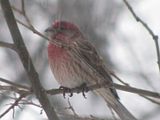
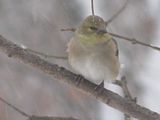
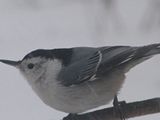
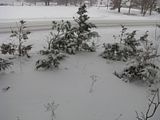
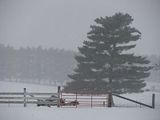
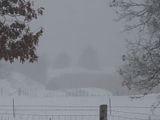
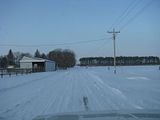
- Quads, hailing from Grand Marsh Observatory atop Elk Castle Hill
-12°F this morning. 5.5" more snow. The next storm? Tomorrow night! Here's a few pictures during the storm yesterday, and after the storm today.









- Quads, hailing from Grand Marsh Observatory atop Elk Castle Hill
During winter evenings, we look toward the edge of the Milky Way galaxy's massive disk of stars. The point that is exactly opposite the center of the galaxy is in the direction of a bright blue star in Taurus called El Nath, which joins the constellation to Auriga.
- Quads, hailing from Grand Marsh Observatory atop Elk Castle Hill
- Quads, hailing from Grand Marsh Observatory atop Elk Castle Hill
Nazca Lines
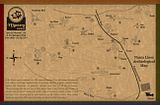
The Nazca Lines are giant sketches drawn in the desert of western Peru by ancient peoples. The drawings were created on such a large scale is such that the shapes can be readily discerned only from the air, leading to a variety of theories about their purpose.
History
The Nazca Lines were created in the time of the Nazca Indians, who flourished in the area from 200 BC to about 600 AD. Graves and ruins of their settlement have been found near the lines.
The lines would have taken a long time to create, perhaps several generations, and many people contributed to their creation. As to the purpose of the Nazca Lines, see below for some of the theories.
What to See
The area of the Peruvian desert in which the Nazca Lines were drawn is called the Pampa Colorada (Red Plain). It is 15 miles wide and runs some 37 miles parallel to the Andes and the Pacific Ocean. The desert is not sandy, but made of dark red surface stones and soil with lighter-colored subsoil beneath. The Lines were created by clearing away the darker upper layer to reveal the lighter subsoil.
It seems incredible that such simply-made drawings have survived for so many hundreds of years, and some have seen a mysterious element to this. But there is also a natural explanation: the surface is made of stone, not sand, and the climate of the area is such that there is practically no erosion. The Nazca peoples chose an excellent place for an enduring monument.
The Nazca Lines include straight lines and geometric shapes as well as stylized depictions of animals, humans and plants. The figures include:
* a monkey
* a condor
* a round-headed, rather friendly-looking human (known as "the astronaut")
* another human figure
* a spider
* a hummingbird
* hands
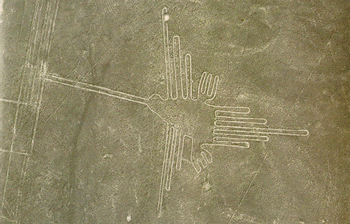
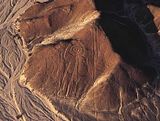
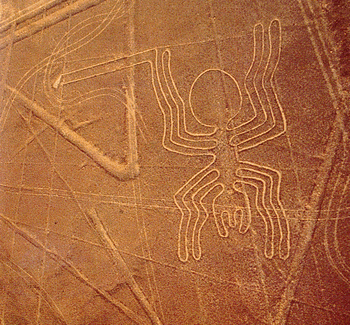
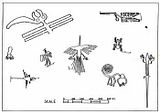
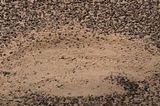
Theories of the Nazca Lines
Theories of the Nazca Lines mainly attempt to explain why these remarkable drawings were created, and some theories seek to address the "how" question as well. Especially in the earlier years of study, it was difficult for many anthropologists to believe that the ancient Nazca peoples could have created the Lines without help from a more advanced society — or species! Perhaps the most famous theory of the Nazca Lines is that of Swiss writer Erich von Däniken. In his 1968 book Chariots of the Gods, he suggested that the lines were built by ancient astronauts as a landing field. He identifies the pictures as "signals" and the longer lines as "landing strips."
In 1977, Jim Woodman accepted that the Nazca people made the lines themselves, but puzzled over why they would make them so big that they couldn't even seen them. He hypothesized that the Nazca people used hot-air balloons for "ceremonial flights" to view their creations. Woodman attempted to demonstrate the validity of his theory by constructing a hot-air balloon out of the materials that would have been available to the Nazca. Using cloth, rope and reeds, Woodman and his colleagues assembled the balloon then risked their lives on a balloon ride that reached a height of 300 feet. The balloon soon descended rapidly; the balloonists bailed out 10 feet above the desert before it crashed some distance away.
In recent years, the professional skeptic Joe Nickell has demonstrated that the drawings would not have been hard to accomplish with only the tools available to the ancient Nazca. Nickell has also shown that although the size of the figures suggests they were intended primarily for the enjoyment of the gods, the drawings can be appreciated from the ground as well.
The general consensus of archaeologists, anthropologists and scientists is that the Nazca Lines were created by the Nazca people themselves, without help from celestial visitors or aerial views. The figures drawn in the desert correspond with images found in other examples of Nazca art, such as pottery.
It is almost certain that the Nazca Lines had a sacred purpose, as the other artifacts of the Nazca culture show a preoccupation with death, all other major monuments of the ancient world were religious in nature, and no plausible practical purpose has yet been discovered.
The Nazca Lines may have been ritual centers for helping the dead achieve immortality; they may have been an offering to the gods; or they could have been a major pilgrimage site. We may never know why the Nazca peoples put so much time and care into a project that they could barely see.
In spite of all that we have learned about them in recent years, the Nazca Lines remain a fascinating mystery.
source....

The Nazca Lines are giant sketches drawn in the desert of western Peru by ancient peoples. The drawings were created on such a large scale is such that the shapes can be readily discerned only from the air, leading to a variety of theories about their purpose.
History
The Nazca Lines were created in the time of the Nazca Indians, who flourished in the area from 200 BC to about 600 AD. Graves and ruins of their settlement have been found near the lines.
The lines would have taken a long time to create, perhaps several generations, and many people contributed to their creation. As to the purpose of the Nazca Lines, see below for some of the theories.
What to See
The area of the Peruvian desert in which the Nazca Lines were drawn is called the Pampa Colorada (Red Plain). It is 15 miles wide and runs some 37 miles parallel to the Andes and the Pacific Ocean. The desert is not sandy, but made of dark red surface stones and soil with lighter-colored subsoil beneath. The Lines were created by clearing away the darker upper layer to reveal the lighter subsoil.
It seems incredible that such simply-made drawings have survived for so many hundreds of years, and some have seen a mysterious element to this. But there is also a natural explanation: the surface is made of stone, not sand, and the climate of the area is such that there is practically no erosion. The Nazca peoples chose an excellent place for an enduring monument.
The Nazca Lines include straight lines and geometric shapes as well as stylized depictions of animals, humans and plants. The figures include:
* a monkey
* a condor
* a round-headed, rather friendly-looking human (known as "the astronaut")
* another human figure
* a spider
* a hummingbird
* hands





Theories of the Nazca Lines
Theories of the Nazca Lines mainly attempt to explain why these remarkable drawings were created, and some theories seek to address the "how" question as well. Especially in the earlier years of study, it was difficult for many anthropologists to believe that the ancient Nazca peoples could have created the Lines without help from a more advanced society — or species! Perhaps the most famous theory of the Nazca Lines is that of Swiss writer Erich von Däniken. In his 1968 book Chariots of the Gods, he suggested that the lines were built by ancient astronauts as a landing field. He identifies the pictures as "signals" and the longer lines as "landing strips."
In 1977, Jim Woodman accepted that the Nazca people made the lines themselves, but puzzled over why they would make them so big that they couldn't even seen them. He hypothesized that the Nazca people used hot-air balloons for "ceremonial flights" to view their creations. Woodman attempted to demonstrate the validity of his theory by constructing a hot-air balloon out of the materials that would have been available to the Nazca. Using cloth, rope and reeds, Woodman and his colleagues assembled the balloon then risked their lives on a balloon ride that reached a height of 300 feet. The balloon soon descended rapidly; the balloonists bailed out 10 feet above the desert before it crashed some distance away.
In recent years, the professional skeptic Joe Nickell has demonstrated that the drawings would not have been hard to accomplish with only the tools available to the ancient Nazca. Nickell has also shown that although the size of the figures suggests they were intended primarily for the enjoyment of the gods, the drawings can be appreciated from the ground as well.
The general consensus of archaeologists, anthropologists and scientists is that the Nazca Lines were created by the Nazca people themselves, without help from celestial visitors or aerial views. The figures drawn in the desert correspond with images found in other examples of Nazca art, such as pottery.
It is almost certain that the Nazca Lines had a sacred purpose, as the other artifacts of the Nazca culture show a preoccupation with death, all other major monuments of the ancient world were religious in nature, and no plausible practical purpose has yet been discovered.
The Nazca Lines may have been ritual centers for helping the dead achieve immortality; they may have been an offering to the gods; or they could have been a major pilgrimage site. We may never know why the Nazca peoples put so much time and care into a project that they could barely see.
In spite of all that we have learned about them in recent years, the Nazca Lines remain a fascinating mystery.
source....
Saturday, December 20, 2008
Friday, December 19, 2008
A few pictures during the snowstorm this morning.
Looks like it's about over now and the Sun is trying to come out. We are already ahead of our snow totals for last year at this time, and last year was a very heavy snow year. At this time last year we had gotten 21.25" of snow. As of today we have 30.10" including the 7.00" this morning.
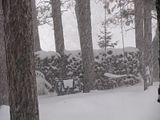

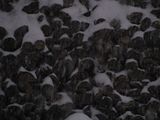

- Quads, hailing from Grand Marsh Observatory atop Elk Castle Hill
Looks like it's about over now and the Sun is trying to come out. We are already ahead of our snow totals for last year at this time, and last year was a very heavy snow year. At this time last year we had gotten 21.25" of snow. As of today we have 30.10" including the 7.00" this morning.




- Quads, hailing from Grand Marsh Observatory atop Elk Castle Hill
Keep your eyes open for an occasional "shooting star" tonight, because Earth will punch through a cloud of comet dust. The dust will create the Ursid meteor shower, which most years is unremarkable. Rarely, though, it puts on an impressive show.
- Quads, hailing from Grand Marsh Observatory atop Elk Castle Hill
- Quads, hailing from Grand Marsh Observatory atop Elk Castle Hill
Ghost Stories: Visits from the Deceased
After a loved one dies, most people see ghosts
Carlos Sluzki’s cat died a while ago now, but he still sometimes visits. Now more of a shadow cat, the former pet seems to lurk at the edges of Sluzki’s vision, as a misinterpreted movement amid the everyday chaos of domestic life. All the same, the shadow cat is beginning to slink away and Sluzki notes that as the grief fades his erstwhile friend is “erasing himself from the world of the present and receding into the bittersweet world of the memories of the loved ones.”
The dead stay with us, that much is clear. They remain in our hearts and minds, of course, but for many people they also linger in our senses—as sights, sounds, smells, touches or presences. Grief hallucinations are a normal reaction to bereavement but are rarely discussed, because people fear they might be considered insane or mentally destabilised by their loss. As a society we tend to associate hallucinations with things like drugs and mental illness, but we now know that hallucinations are common in sober healthy people and that they are more likely during times of stress.
Mourning seems to be a time when hallucinations are particularly common, to the point where feeling the presence of the deceased is the norm rather than the exception. One study, by the researcher Agneta Grimby at the University of Goteborg, found that over 80 percent of elderly people experience hallucinations associated with their dead partner one month after bereavement, as if their perception had yet to catch up with the knowledge of their beloved’s passing. As a marker of how vivid such visions can seem, almost a third of the people reported that they spoke in response to their experiences. In other words, these weren’t just peripheral illusions: they could evoke the very essence of the deceased.
source....
After a loved one dies, most people see ghosts
Carlos Sluzki’s cat died a while ago now, but he still sometimes visits. Now more of a shadow cat, the former pet seems to lurk at the edges of Sluzki’s vision, as a misinterpreted movement amid the everyday chaos of domestic life. All the same, the shadow cat is beginning to slink away and Sluzki notes that as the grief fades his erstwhile friend is “erasing himself from the world of the present and receding into the bittersweet world of the memories of the loved ones.”
The dead stay with us, that much is clear. They remain in our hearts and minds, of course, but for many people they also linger in our senses—as sights, sounds, smells, touches or presences. Grief hallucinations are a normal reaction to bereavement but are rarely discussed, because people fear they might be considered insane or mentally destabilised by their loss. As a society we tend to associate hallucinations with things like drugs and mental illness, but we now know that hallucinations are common in sober healthy people and that they are more likely during times of stress.
Mourning seems to be a time when hallucinations are particularly common, to the point where feeling the presence of the deceased is the norm rather than the exception. One study, by the researcher Agneta Grimby at the University of Goteborg, found that over 80 percent of elderly people experience hallucinations associated with their dead partner one month after bereavement, as if their perception had yet to catch up with the knowledge of their beloved’s passing. As a marker of how vivid such visions can seem, almost a third of the people reported that they spoke in response to their experiences. In other words, these weren’t just peripheral illusions: they could evoke the very essence of the deceased.
source....
Thursday, December 18, 2008
-9°F this morning. More snow on the way tonight. Anywhere from 4" to 12" depending on which forecast you believe. Then another longer duration snowstorm this weekend, starting Saturday all the way to Monday! Doesn't look like I'll be able to get out in the woods to cut firewood this winter either. Maybe I'd buy a cheap used snowmobile, if only I had a place to store it, possibly for no other reason than to pack my woods trails down so I could haul firewood with my Hawkeye!
- Quads, hailing from Grand Marsh Observatory atop Elk Castle Hill
- Quads, hailing from Grand Marsh Observatory atop Elk Castle Hill
Mormon missionaries find sasquatch print
Two missionaries with the Church of Jesus Christ of Latter Day Saints received a scare on the night of Dec. 2 when they saw what they think was a set of sasquatch footprints outside of their Burns Lake home.
Tyler Beck and Brad Blazzard are in B.C. for two years, rotating in different communities throughout the Smithers and Burns Lake area for the past seven months.
"The first thing we thought was that someone was playing a trick on us," Beck said."But we don't know anyone our age who would do that and our house in on the southside, so pretty much in the middle of nowhere."
The footprints, which Beck said was about 20 inches long is right in front of Beck's porch, leading to the path where the pair keep their wood shed.
Beck said prior to finding the footprint at 9:30 p.m. on the night of Dec. 2, he didn't really believe in the possibility of bigfoot.
"I still don't know what to think," he said. "I have heard some pretty ridiculous things about bigfoot but now I am leaning toward the edge of thinking it may be possible."
The house sits in front of a lake and Beck said in the four-and-a-half months he has been there, he has seen all manner of coyotes and wolves. This is the first time he has seen any sign of the fabled creature.
Another women apparently told friends that she had seen a sasquatch peeking in someone’s window.
The last report allegedly involved a school bus driver who saw the creature standing in a field.
A sighting in Houston in late July by Delores Harrie captured international media attention.
Harrie saw the creature out at her home on Buck Flats Road on July 28.
At 5:45 a.m. that morning, Harrie heard her dogs barking at the door. When she went down to investigate she saw that someone or something was rattling the door handle.
She eventually opened the door and the dogs were out like a shot, sniffing out something on he east side of her property.
When she looked out at the side of her house, she saw a creature that was walking on two legs.
“It was huge and it had long hair, not fur — kind of like the kind you see on an ox and a reddish brown, the colour of the trees that are killed by the pine beetle,” said the woman. “And it moved so fast, by the time I opened my door it had run from the porch to the other side of the house.”
Once outside, the dogs pursued the creature it continued along a dried-up ravine and disappeared into a forested area. Her oldest dog didn’t return for three hours.
“I was worried but what do you do, tell people your dog is chasing bigfoot?” she asked. “I drove up and down the road, looking for him and eventually he came back.”
After Harrie’s report, there was a report on Telkwa High Road and sightings in Campbell River.
source....
Two missionaries with the Church of Jesus Christ of Latter Day Saints received a scare on the night of Dec. 2 when they saw what they think was a set of sasquatch footprints outside of their Burns Lake home.
Tyler Beck and Brad Blazzard are in B.C. for two years, rotating in different communities throughout the Smithers and Burns Lake area for the past seven months.
"The first thing we thought was that someone was playing a trick on us," Beck said."But we don't know anyone our age who would do that and our house in on the southside, so pretty much in the middle of nowhere."
The footprints, which Beck said was about 20 inches long is right in front of Beck's porch, leading to the path where the pair keep their wood shed.
Beck said prior to finding the footprint at 9:30 p.m. on the night of Dec. 2, he didn't really believe in the possibility of bigfoot.
"I still don't know what to think," he said. "I have heard some pretty ridiculous things about bigfoot but now I am leaning toward the edge of thinking it may be possible."
The house sits in front of a lake and Beck said in the four-and-a-half months he has been there, he has seen all manner of coyotes and wolves. This is the first time he has seen any sign of the fabled creature.
Another women apparently told friends that she had seen a sasquatch peeking in someone’s window.
The last report allegedly involved a school bus driver who saw the creature standing in a field.
A sighting in Houston in late July by Delores Harrie captured international media attention.
Harrie saw the creature out at her home on Buck Flats Road on July 28.
At 5:45 a.m. that morning, Harrie heard her dogs barking at the door. When she went down to investigate she saw that someone or something was rattling the door handle.
She eventually opened the door and the dogs were out like a shot, sniffing out something on he east side of her property.
When she looked out at the side of her house, she saw a creature that was walking on two legs.
“It was huge and it had long hair, not fur — kind of like the kind you see on an ox and a reddish brown, the colour of the trees that are killed by the pine beetle,” said the woman. “And it moved so fast, by the time I opened my door it had run from the porch to the other side of the house.”
Once outside, the dogs pursued the creature it continued along a dried-up ravine and disappeared into a forested area. Her oldest dog didn’t return for three hours.
“I was worried but what do you do, tell people your dog is chasing bigfoot?” she asked. “I drove up and down the road, looking for him and eventually he came back.”
After Harrie’s report, there was a report on Telkwa High Road and sightings in Campbell River.
source....
Wednesday, December 17, 2008
http://www.dnr.state.wi.us/org/land/parks/regions/wcr/blackr.html
will be closed to ATVs whenever the trails have been groomed
What the hell does that mean??? ATVing in this state is getting more and more complicated and less and less trails. Maybe they should more than double the registration fee to make more places to ride? It was a better state to ride in when the fee was only $12. DUH.
- Quads, hailing from Grand Marsh Observatory atop Elk Castle Hill
One new change to the trails this year is that the Oak Ridge trail running south from Castle Mound to Millston will be closed to ATVs whenever the trails have been groomed. This is due to a change in Jackson County's trail ordinances. ATV riders will still be able to get to Millston by travelling east of Castle Mound.
will be closed to ATVs whenever the trails have been groomed
What the hell does that mean??? ATVing in this state is getting more and more complicated and less and less trails. Maybe they should more than double the registration fee to make more places to ride? It was a better state to ride in when the fee was only $12. DUH.
- Quads, hailing from Grand Marsh Observatory atop Elk Castle Hill
Residents of Maine town want to keep stars in their eyes
Approve ordinance to redirect man-made light

On a clear night, the Milky Way cuts across the sky and down to the horizon like a celestial lightning bolt, a giant, luminescent spear shrouded in a graceful veil of back-lighted stardust.
Paul Paradis, a town councilor and hardware store owner, voted against the ordinance, which he calls "intrusive."
GOOD NEIGHBOR LAWS
The sight has always been up there. But today, few Americans can see it, especially not in brightly lighted cities like Boston. On the densely populated East Coast, Mount Desert Island is one of the last inhabited places where the naked eye can still clearly observe the heavenly wonders that have inspired religion, mythology, science, and culture.
To preserve that natural spectacle - and protect one of the tourist attractions of the island's Acadia National Park - voters in Bar Harbor this month approved a "dark sky" ordinance aimed at limiting the manmade lighting that has blotted out the view of the stars over much of the country. Bright lights installed after Dec. 4 will have to be shielded from the sky to illuminate only the area beneath them.
"The idea is you put the light where you need it," said Peter Lord, who directs Island Astronomy Institute, a nonprofit organization on Mount Desert Island that studies the effect of manmade light on the night sky.
"There are many in Boston who have never seen the full specter of the Milky Way. In the United States, what you have is a generation of children who have never seen it."
Preserving the sight the ancients took for granted goes beyond saving a pretty view. The promise of a rare, unimpeded stargazing experience has the potential to draw more visitors to Maine, which depends heavily on tourism.
Chris Fogg, executive director of the Bar Harbor Chamber of Commerce, estimates that 20 million people live within a day's drive of the Down East resort - all potential visitors, especially during an economic downturn, when many people go sightseeing closer to home.
He cites a recent National Geographic article that recommends Bar Harbor as one of the four best places in the country to see the stars.
Lord, who helped draft the ordinance, sees it as a stepping stone toward a more light-conscious society, in which understanding the correlation between the use of light and the view of the night sky becomes as widespread as people's awareness that recycling is good for the environment.
"If we are able to document the change," Lord said, "Bar Harbor will be able to encourage people to go beyond the basic minimum requirements of the ordinance."
Bar Harbor's night skies are so clear because the town sits on an island with no industry, a national park, and a large section of coastline that faces open ocean.
Three other communities on the island already enforce some restrictions on outdoor lights, but just a few miles over the bridge that connects Mount Desert Island to the mainland is Ellsworth, where signs and glaring parking lots cast a bright, yellow haze.
source....
Approve ordinance to redirect man-made light

On a clear night, the Milky Way cuts across the sky and down to the horizon like a celestial lightning bolt, a giant, luminescent spear shrouded in a graceful veil of back-lighted stardust.
Paul Paradis, a town councilor and hardware store owner, voted against the ordinance, which he calls "intrusive."
GOOD NEIGHBOR LAWS
The sight has always been up there. But today, few Americans can see it, especially not in brightly lighted cities like Boston. On the densely populated East Coast, Mount Desert Island is one of the last inhabited places where the naked eye can still clearly observe the heavenly wonders that have inspired religion, mythology, science, and culture.
To preserve that natural spectacle - and protect one of the tourist attractions of the island's Acadia National Park - voters in Bar Harbor this month approved a "dark sky" ordinance aimed at limiting the manmade lighting that has blotted out the view of the stars over much of the country. Bright lights installed after Dec. 4 will have to be shielded from the sky to illuminate only the area beneath them.
"The idea is you put the light where you need it," said Peter Lord, who directs Island Astronomy Institute, a nonprofit organization on Mount Desert Island that studies the effect of manmade light on the night sky.
"There are many in Boston who have never seen the full specter of the Milky Way. In the United States, what you have is a generation of children who have never seen it."
Preserving the sight the ancients took for granted goes beyond saving a pretty view. The promise of a rare, unimpeded stargazing experience has the potential to draw more visitors to Maine, which depends heavily on tourism.
Chris Fogg, executive director of the Bar Harbor Chamber of Commerce, estimates that 20 million people live within a day's drive of the Down East resort - all potential visitors, especially during an economic downturn, when many people go sightseeing closer to home.
He cites a recent National Geographic article that recommends Bar Harbor as one of the four best places in the country to see the stars.
Lord, who helped draft the ordinance, sees it as a stepping stone toward a more light-conscious society, in which understanding the correlation between the use of light and the view of the night sky becomes as widespread as people's awareness that recycling is good for the environment.
"If we are able to document the change," Lord said, "Bar Harbor will be able to encourage people to go beyond the basic minimum requirements of the ordinance."
Bar Harbor's night skies are so clear because the town sits on an island with no industry, a national park, and a large section of coastline that faces open ocean.
Three other communities on the island already enforce some restrictions on outdoor lights, but just a few miles over the bridge that connects Mount Desert Island to the mainland is Ellsworth, where signs and glaring parking lots cast a bright, yellow haze.
source....
Tuesday, December 16, 2008
ANOTHER...POTENTIALLY STRONGER WINTER STORM WILL MOVE OUT OF
THE SOUTHERN PLAINS AND INTO THE EASTERN GREAT LAKES BY FRIDAY
MORNING. HEAVY SNOWS LOOK LIKELY NORTH OF THE STORM TRACK...WHICH
WOULD IMPACT SOUTHEAST MINNESOTA...NORTHEAST IOWA AND SOUTHERN
WISCONSIN. CURRENT TIMING WOULD BRING THE BRUNT OF THE STORM INTO
THE REGION THURSDAY EVENING. A WINTER STORM WATCH WILL BE NEEDED IF
THE PROJECTED STORM TRACK STAYS ON ITS CURRENT PATH.
THE SOUTHERN PLAINS AND INTO THE EASTERN GREAT LAKES BY FRIDAY
MORNING. HEAVY SNOWS LOOK LIKELY NORTH OF THE STORM TRACK...WHICH
WOULD IMPACT SOUTHEAST MINNESOTA...NORTHEAST IOWA AND SOUTHERN
WISCONSIN. CURRENT TIMING WOULD BRING THE BRUNT OF THE STORM INTO
THE REGION THURSDAY EVENING. A WINTER STORM WATCH WILL BE NEEDED IF
THE PROJECTED STORM TRACK STAYS ON ITS CURRENT PATH.
My personality type: ISTJ
Serious and quiet, interested in security and peaceful living. Extremely thorough, responsible and dependable. Well-developed powers of concentration. Usually interested in supporting and promoting traditions and establishments. Well-organized and hard working, work steadily towards identified goals. Can usually accomplish any task once having set a mind to it.
Careers that could fit me include:
Business executives, administrators and managers, accountants, police, detectives, judges, lawyers, medical doctors, dentists, computer programmers, systems analysts, computer specialists, auditors, electricians, math teachers, mechanical engineers, steelworkers, technicians.
What personality type are you? Take the free test at www.41q.com and find out.
- Quads, hailing from Grand Marsh Observatory atop Elk Castle Hill
Serious and quiet, interested in security and peaceful living. Extremely thorough, responsible and dependable. Well-developed powers of concentration. Usually interested in supporting and promoting traditions and establishments. Well-organized and hard working, work steadily towards identified goals. Can usually accomplish any task once having set a mind to it.
Careers that could fit me include:
Business executives, administrators and managers, accountants, police, detectives, judges, lawyers, medical doctors, dentists, computer programmers, systems analysts, computer specialists, auditors, electricians, math teachers, mechanical engineers, steelworkers, technicians.
What personality type are you? Take the free test at www.41q.com and find out.
- Quads, hailing from Grand Marsh Observatory atop Elk Castle Hill
-11°F this morning. This is the weather that makes the hard work of wood heat all worthwhile. It really pays off. I hope sometime this winter we have little snow on the ground so I can get out and cut some more wood. I can cut with a lot of snow, but I can't get out there and back! Not to mention being unable to pull a trailer load through the deep snow.
- Quads, hailing from Grand Marsh Observatory atop Elk Castle Hill
- Quads, hailing from Grand Marsh Observatory atop Elk Castle Hill
UFOs, aliens and ghosts are believed in more than God
Believers in UFOs, aliens and ghosts outnumber those who follow mainstream religions, a survey has found.
A picture taken by an East German NVA unit in 1982.
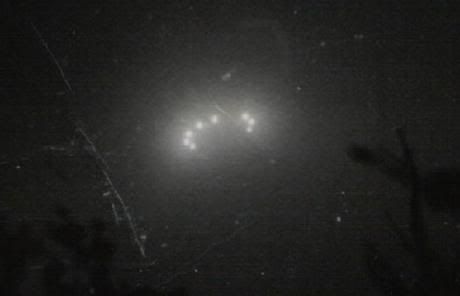
While 54 per cent of people believe in God, 58 per cent believe in the supernatural.
Researchers found women were more likely to believe in the supernatural than men, and were more likely to visit a medium.
Nearly a quarter of the 3,000 questioned by researchers claimed they had an encounter with the paranormal.
Some 37 per cent said aliens and ghosts were the basis of their belief system.
The study, to mark the DVD release of X Files: I Want to Believe, conflicts with another report that showed 68.5 per cent of the general UK population described themselves as believers .
Files released in October revealed cases of passenger jets nearly colliding with UFOs and reports of alien abduction which have been logged by the Ministry of Defence.
The 19 files, disclosed by the National Archives which date from 1986 to 1992, show the extensive records of strange sightings by members of the public and unexplained radar images from air traffic control.
In the files, the military admitted the sighting in April 1991 could not be explained, having ruled out a British or American missile.
It concluded: "In the absence of any clear evidence which could be used to identify the object, it is our intention to treat this sighting like that of any other Unidentified Flying Object."
source....
Believers in UFOs, aliens and ghosts outnumber those who follow mainstream religions, a survey has found.

While 54 per cent of people believe in God, 58 per cent believe in the supernatural.
Researchers found women were more likely to believe in the supernatural than men, and were more likely to visit a medium.
Nearly a quarter of the 3,000 questioned by researchers claimed they had an encounter with the paranormal.
Some 37 per cent said aliens and ghosts were the basis of their belief system.
The study, to mark the DVD release of X Files: I Want to Believe, conflicts with another report that showed 68.5 per cent of the general UK population described themselves as believers .
Files released in October revealed cases of passenger jets nearly colliding with UFOs and reports of alien abduction which have been logged by the Ministry of Defence.
The 19 files, disclosed by the National Archives which date from 1986 to 1992, show the extensive records of strange sightings by members of the public and unexplained radar images from air traffic control.
In the files, the military admitted the sighting in April 1991 could not be explained, having ruled out a British or American missile.
It concluded: "In the absence of any clear evidence which could be used to identify the object, it is our intention to treat this sighting like that of any other Unidentified Flying Object."
source....
Monday, December 15, 2008
Heard on the radio this morning:
I was Christmas shopping yesterday. I see that they have a new Green Bay Packer doll. It's just like a real Packer, it can't play football either.
At least the Packers have someplace to run without the cops chasing them.
Temperature drop from yesterday/this morning, and still dropping. Gap in the curve is weather station downtime.
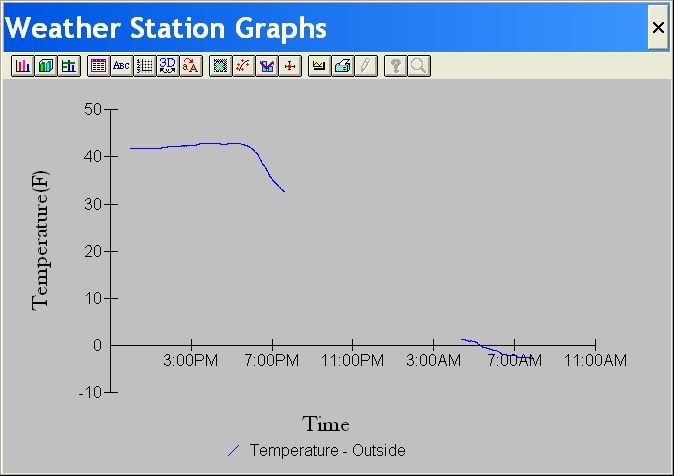
Weather station display from a few moments ago.
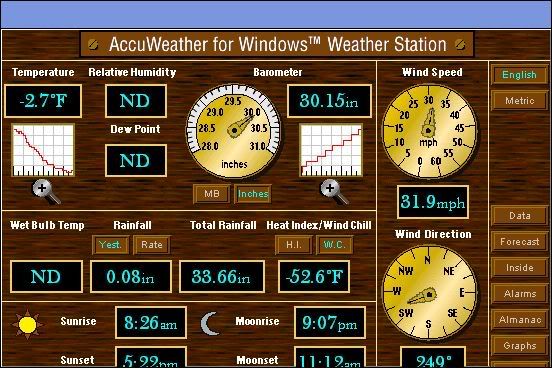
- Quads, hailing from Grand Marsh Observatory atop Elk Castle Hill
I was Christmas shopping yesterday. I see that they have a new Green Bay Packer doll. It's just like a real Packer, it can't play football either.
At least the Packers have someplace to run without the cops chasing them.


- Quads, hailing from Grand Marsh Observatory atop Elk Castle Hill
STAR GAZER
Episode # 08-50 / 1619th Show
To Be Aired : Monday 12/15/2008 through Sunday 12/21/2008
"The So-Called "Christmas Star" Returns
Accompanied By A Companion!"
Horkheimer: Greetings, greetings fellow star gazers. Every few years during the Christmas season an extremely bright star-like object appears in early evening, which prompts many people to ask, "is it the Christmas Star?" And once again it has returned for the holiday season and is the brightest object we can see in the nighttime sky second only to the Moon. But this year it has returned with a companion, which is the third brightest object we can ever see in the nighttime sky. Let me explain.
O.K., we've got out our skies set up for any night during Christmas week about 45 minutes after sunset facing southwest where the brightest object you'll see will be the so-called Christmas Star. And down to its right a not quite as bright star-like object, a companion to the so-called Christmas Star. But even though both of them look like incredibly brilliant stars nothing could be farther from the truth. In fact they are much closer than any star other than our Sun. In fact they are part of our Sun's family, two planets. The one closest to the horizon is the king of the planets itself, Jupiter.
And if you get a small telescope for Christmas you'll be absolutely fascinated at the detail you can see. You'll be able to make out horizontal lines, which are bands of huge gigantic storms, which continually encircle this planet. And you'll also see tiny pinpoints of light lined up on either side of Jupiter, which are its four largest moons. Plus if you go out hour after hour night after night you'll notice that they constantly change their position in relation to Jupiter and each other. And that is because they are constantly moving in orbit around it. So that's the story behind this year's Christmas Star's companion.
The so-called Christmas Star is also a planet, the most reflective planet of them all because it is constantly enshrouded by a dense cloud cover, which makes this planet act like a giant mirror. It is our nearest neighbor in space other than the Moon, Venus. And for centuries whenever Venus has made its appearance during the Christmas season, people have mistaken it for the star mentioned in the Christmas story. And if you look at it through a small telescope you will see that it goes through phases just like our Moon. In fact during Christmas week this year it will look like a just past first quarter Moon.
Now Venus which is almost the same size as our Earth, is much smaller than Jupiter, only 8,000 miles wide whereas Jupiter is 88,000 miles wide which means we could line up eleven Venuses across its middle which tells us that it must be super close to be so much brighter than Jupiter. How close you ask? Well all during Christmas week Venus will be only 78 million miles away from earth but Jupiter will be a whopping seven times farther away, 558 million miles beyond. Which may lead you to ask, "If Jupiter were as close to Earth as Venus, how bright would it be in our night sky?" Answer: 50 times brighter! So bright we'd see it every day in the daytime sky. So get thee out all during Christmas week just after sunset and enjoy the beauty of the two brightest planets in our solar system. And see if they don't make your holiday just a little bit brighter. Keep looking up!
Episode # 08-50 / 1619th Show
To Be Aired : Monday 12/15/2008 through Sunday 12/21/2008
"The So-Called "Christmas Star" Returns
Accompanied By A Companion!"
Horkheimer: Greetings, greetings fellow star gazers. Every few years during the Christmas season an extremely bright star-like object appears in early evening, which prompts many people to ask, "is it the Christmas Star?" And once again it has returned for the holiday season and is the brightest object we can see in the nighttime sky second only to the Moon. But this year it has returned with a companion, which is the third brightest object we can ever see in the nighttime sky. Let me explain.
O.K., we've got out our skies set up for any night during Christmas week about 45 minutes after sunset facing southwest where the brightest object you'll see will be the so-called Christmas Star. And down to its right a not quite as bright star-like object, a companion to the so-called Christmas Star. But even though both of them look like incredibly brilliant stars nothing could be farther from the truth. In fact they are much closer than any star other than our Sun. In fact they are part of our Sun's family, two planets. The one closest to the horizon is the king of the planets itself, Jupiter.
And if you get a small telescope for Christmas you'll be absolutely fascinated at the detail you can see. You'll be able to make out horizontal lines, which are bands of huge gigantic storms, which continually encircle this planet. And you'll also see tiny pinpoints of light lined up on either side of Jupiter, which are its four largest moons. Plus if you go out hour after hour night after night you'll notice that they constantly change their position in relation to Jupiter and each other. And that is because they are constantly moving in orbit around it. So that's the story behind this year's Christmas Star's companion.
The so-called Christmas Star is also a planet, the most reflective planet of them all because it is constantly enshrouded by a dense cloud cover, which makes this planet act like a giant mirror. It is our nearest neighbor in space other than the Moon, Venus. And for centuries whenever Venus has made its appearance during the Christmas season, people have mistaken it for the star mentioned in the Christmas story. And if you look at it through a small telescope you will see that it goes through phases just like our Moon. In fact during Christmas week this year it will look like a just past first quarter Moon.
Now Venus which is almost the same size as our Earth, is much smaller than Jupiter, only 8,000 miles wide whereas Jupiter is 88,000 miles wide which means we could line up eleven Venuses across its middle which tells us that it must be super close to be so much brighter than Jupiter. How close you ask? Well all during Christmas week Venus will be only 78 million miles away from earth but Jupiter will be a whopping seven times farther away, 558 million miles beyond. Which may lead you to ask, "If Jupiter were as close to Earth as Venus, how bright would it be in our night sky?" Answer: 50 times brighter! So bright we'd see it every day in the daytime sky. So get thee out all during Christmas week just after sunset and enjoy the beauty of the two brightest planets in our solar system. And see if they don't make your holiday just a little bit brighter. Keep looking up!
Sunday, December 14, 2008
Hubble Captures Images of Rare Mammoth Stars

The Hubble Space Telescope has revealed two of the most massive stars in our galaxy as never before. Located 7,500 light years away from Earth in the Carina Nebula, these stars are rare ultra-hot, super-bright stars that emit primarily ultraviolet radiation, that gives them a blue hue.
WR25, the brightest of the stars, is actually a large star 50 times the size of our sun with another star half that size orbiting around it. To the upper left of WR25, the third brightest star in this image is really a triple star cluster. Two are so close together that telescopes with less resolution can't resolve them. The third star may take hundreds of thousands of years to orbit around them.
The second brightest star is actually a less massive star that appears bright because it is much closer to earth than the others.
Astronomers, led by Jesus Maiz Apellaniz at the Instituto de Astrofisico De Andalucia in Spain, believe radiation from the two star clusters may be causing a giant gas globule in the Carina Nebula to evaporate, inducing new stars to form and giving the globule its strange shape.
Hubble got back up and running in late October with its on-board back-up system after its primary camera malfunctioned. NASA is working to fix a spare system on the ground that could be delivered to the telescope by the space shuttle. A repair mission originally scheduled for October 14, before the breakdown, has been pushed back.
source....

The Hubble Space Telescope has revealed two of the most massive stars in our galaxy as never before. Located 7,500 light years away from Earth in the Carina Nebula, these stars are rare ultra-hot, super-bright stars that emit primarily ultraviolet radiation, that gives them a blue hue.
WR25, the brightest of the stars, is actually a large star 50 times the size of our sun with another star half that size orbiting around it. To the upper left of WR25, the third brightest star in this image is really a triple star cluster. Two are so close together that telescopes with less resolution can't resolve them. The third star may take hundreds of thousands of years to orbit around them.
The second brightest star is actually a less massive star that appears bright because it is much closer to earth than the others.
Astronomers, led by Jesus Maiz Apellaniz at the Instituto de Astrofisico De Andalucia in Spain, believe radiation from the two star clusters may be causing a giant gas globule in the Carina Nebula to evaporate, inducing new stars to form and giving the globule its strange shape.
Hubble got back up and running in late October with its on-board back-up system after its primary camera malfunctioned. NASA is working to fix a spare system on the ground that could be delivered to the telescope by the space shuttle. A repair mission originally scheduled for October 14, before the breakdown, has been pushed back.
source....
Saturday, December 13, 2008
Massive fireball lights up the night sky
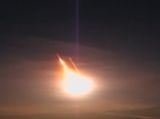
People across Western Canada are still talking about a massive fireball that cut through the night sky on Thursday.
The object was spotted at around 17:30 MST and was spotted by people living in Alberta, Saskatchewan, Manitoba, and even North Dakota.
The object is believed to have been a meteor, but according to Alan Dyer with the Telus World of Science in Calgary, confirmation of what it was and where it landed may not be known for a few more days.
The spectacular light display in the night sky demanded the attention of many who were either at home, driving or just outside.
"All of a sudden the sky just lit up and I saw this huge ball of fire coming down from the sky," said Albertan Sandy Wallin.
It seemed, depending on where people caught the light show, there were varying descriptions. Most witnesses described the event at first as a reddish or orange light that blazed across the sky and then exploded into a fireball.
Rob Westland witnessed the object while driving his son home from volleyball practice in Patricia, Alberta, He described the fireball as white, blue and green and the entire event lasted only seconds.
People living in northern Alberta and Saskatchewan believed the light streaked near the provinces' borders and made contact with earth there.
"I saw this brilliant light coming down from the sky to the south and... it was so bright that it almost blinded me to look at it," said Donna Wesley, who was driving at the time.
Davidson Family was driving from Red Deer to Edmonton when he saw the luminous object that he said had a tail.
"I hear like this thing, it's like a jet or something, and I look and it's like this big white flash."
"As it goes through the atmosphere at ultrasonic speeds, huge speeds, it causes the air around it to glow and light up," Alan Dyer said. He believes the object is likely a meteor or "meteorite" if it hit the earth. "By all reports, it was very quick, very fast, and so that suggests it's from the asteroid belt, it's a piece of natural space debris."
Dyer says there are a number of cameras across the province for university researchers and it will take time for them to go through the photos to figure out what it was.
If the meteor was captured by more than one of the cameras, it may be possible over the next couple of days to triangulate exactly where it touched down -- if it did.
"There's a very good chance it was what we call a bull's eye, which is a meteorite crossing the sky at extremely quick velocity -- very, very fast -- and as it hits the atmosphere at about 400,000 feet, travelling at about 60 kilometres per second, this is the incredible light show that it creates," said Edmonton space educator Randy Atwood.
Atwood said the meteor was probably no bigger than a grapefruit, and may have broken into small pieces before hitting the ground, or it may have burned up entirely before touching down.
"It was a beautiful show and some people might have thought it was just over the hill, and that it was the size of a house," he said.
Officials at the North American Aerospace Defense Command (NORAD) confirmed whatever was seen was not man-made and does not pose a threat to security.
source....

People across Western Canada are still talking about a massive fireball that cut through the night sky on Thursday.
The object was spotted at around 17:30 MST and was spotted by people living in Alberta, Saskatchewan, Manitoba, and even North Dakota.
The object is believed to have been a meteor, but according to Alan Dyer with the Telus World of Science in Calgary, confirmation of what it was and where it landed may not be known for a few more days.
The spectacular light display in the night sky demanded the attention of many who were either at home, driving or just outside.
"All of a sudden the sky just lit up and I saw this huge ball of fire coming down from the sky," said Albertan Sandy Wallin.
It seemed, depending on where people caught the light show, there were varying descriptions. Most witnesses described the event at first as a reddish or orange light that blazed across the sky and then exploded into a fireball.
Rob Westland witnessed the object while driving his son home from volleyball practice in Patricia, Alberta, He described the fireball as white, blue and green and the entire event lasted only seconds.
People living in northern Alberta and Saskatchewan believed the light streaked near the provinces' borders and made contact with earth there.
"I saw this brilliant light coming down from the sky to the south and... it was so bright that it almost blinded me to look at it," said Donna Wesley, who was driving at the time.
Davidson Family was driving from Red Deer to Edmonton when he saw the luminous object that he said had a tail.
"I hear like this thing, it's like a jet or something, and I look and it's like this big white flash."
"As it goes through the atmosphere at ultrasonic speeds, huge speeds, it causes the air around it to glow and light up," Alan Dyer said. He believes the object is likely a meteor or "meteorite" if it hit the earth. "By all reports, it was very quick, very fast, and so that suggests it's from the asteroid belt, it's a piece of natural space debris."
Dyer says there are a number of cameras across the province for university researchers and it will take time for them to go through the photos to figure out what it was.
If the meteor was captured by more than one of the cameras, it may be possible over the next couple of days to triangulate exactly where it touched down -- if it did.
"There's a very good chance it was what we call a bull's eye, which is a meteorite crossing the sky at extremely quick velocity -- very, very fast -- and as it hits the atmosphere at about 400,000 feet, travelling at about 60 kilometres per second, this is the incredible light show that it creates," said Edmonton space educator Randy Atwood.
Atwood said the meteor was probably no bigger than a grapefruit, and may have broken into small pieces before hitting the ground, or it may have burned up entirely before touching down.
"It was a beautiful show and some people might have thought it was just over the hill, and that it was the size of a house," he said.
Officials at the North American Aerospace Defense Command (NORAD) confirmed whatever was seen was not man-made and does not pose a threat to security.
source....
Friday, December 12, 2008
America’s forgotten freedoms
A survey by the First Amendment Center in the US has reached the shocking conclusion that most American citizens don’t know the five basic freedoms enshrined in the constitution.
The study found that no more than 3% of Americans remember “petition” among the First Amendment’s five basic freedoms.
However, freedom of speech was remembered by the majority of respondents - 56%.
The others freedoms enshrined in the constitution appeared to have made little impression: freedom of religion was named by 15%; the same percentage remembered press freedom as a constitutional right while just 14% knew they had a right to assembly.
The number of respondents who remembered freedom of speech was the lowest in the history of the survey, conducted each year for the past eleven years.
What makes this year’s results more shocking is that 4 out of 10 people questioned could not name any freedom at all.
Whatever freedoms the constitution of the country may guarantee, it does not matter much since these rights are neither remembered nor needed as such.
The findings indicate that modern Americans do not think along the same lines as the Founders of the U.S.
Nowadays, it would seem, many Americans do not consider their basic rights and freedoms inalienable and are ready to delegate them to state or federal officials.
More than two centuries ago it did not take long for the Founders of the United States of America to realize the necessity of preserving individual freedoms in a system of individual states with a strong federal governmental centre.
-The First Amendment to the U.S. Constitution
In 1791, just four years after the declaration in 1787 of the American Constitution, the states adopted the First Amendment together with the Bill of Rights to guarantee that the strong federal government would not trample on basic individual rights and freedoms.
Moreover, there are rights totally forgotten by the American society, meaning most Americans are not familiar with the freedoms guaranteed by the American Constitution.
Freedom of speech and religion are among the first but liberties introduced to the American Constitution by the Bill of Rights. Traditionally, most of the questioned Americans recalled them. But regarding freedom of the press, freedom to assemble and to petition - these seem to be lost in oblivion.
The annual State of the First Amendment survey, held by the First Amendment Center (www.firstamendmentcenter.org), questions adult Americans on their attitude towards the rights spelled out in the First Amendment. This year it found the following:
• 39% would extend to subscription cable and satellite television the government’s current authority to regulate content on over-the-air broadcast television.
• 54% would continue IRS regulations that bar religious leaders from openly endorsing political candidates from the pulpit without endangering the tax-exempt status of their organizations.
• 66% say the government should be able to require television broadcasters to offer an equal allotment of time to conservative and liberal broadcasters; 62% would apply that same requirement to newspapers, which never have had content regulated by the government.
• 38% would permit government to require broadcasters to report a specified amount of “positive news” in return for licenses to operate.
• 31% would not permit musicians to sing songs with lyrics that others might find offensive.
• 68% favor government restrictions on campaign contributions by private companies, and 55% favor such limits on amounts individuals can contribute to someone else’s campaign.
Thus, a large number of Americans concede that in specific cases the federal government can be involved or even control individual freedoms.
The most shocking conclusion of the survey was that most of Americans could not name the five basic freedoms enshrined in the constitution.
source....
A survey by the First Amendment Center in the US has reached the shocking conclusion that most American citizens don’t know the five basic freedoms enshrined in the constitution.
The study found that no more than 3% of Americans remember “petition” among the First Amendment’s five basic freedoms.
However, freedom of speech was remembered by the majority of respondents - 56%.
The others freedoms enshrined in the constitution appeared to have made little impression: freedom of religion was named by 15%; the same percentage remembered press freedom as a constitutional right while just 14% knew they had a right to assembly.
The number of respondents who remembered freedom of speech was the lowest in the history of the survey, conducted each year for the past eleven years.
What makes this year’s results more shocking is that 4 out of 10 people questioned could not name any freedom at all.
Whatever freedoms the constitution of the country may guarantee, it does not matter much since these rights are neither remembered nor needed as such.
The findings indicate that modern Americans do not think along the same lines as the Founders of the U.S.
Nowadays, it would seem, many Americans do not consider their basic rights and freedoms inalienable and are ready to delegate them to state or federal officials.
More than two centuries ago it did not take long for the Founders of the United States of America to realize the necessity of preserving individual freedoms in a system of individual states with a strong federal governmental centre.
Congress shall make no law respecting an establishment of religion, or prohibiting the free exercise thereof; or abridging the freedom of speech, or of the press; or the right of the people peaceably to assemble, and to petition the Government for a redress of grievances.
-The First Amendment to the U.S. Constitution
In 1791, just four years after the declaration in 1787 of the American Constitution, the states adopted the First Amendment together with the Bill of Rights to guarantee that the strong federal government would not trample on basic individual rights and freedoms.
Moreover, there are rights totally forgotten by the American society, meaning most Americans are not familiar with the freedoms guaranteed by the American Constitution.
Freedom of speech and religion are among the first but liberties introduced to the American Constitution by the Bill of Rights. Traditionally, most of the questioned Americans recalled them. But regarding freedom of the press, freedom to assemble and to petition - these seem to be lost in oblivion.
The annual State of the First Amendment survey, held by the First Amendment Center (www.firstamendmentcenter.org), questions adult Americans on their attitude towards the rights spelled out in the First Amendment. This year it found the following:
• 39% would extend to subscription cable and satellite television the government’s current authority to regulate content on over-the-air broadcast television.
• 54% would continue IRS regulations that bar religious leaders from openly endorsing political candidates from the pulpit without endangering the tax-exempt status of their organizations.
• 66% say the government should be able to require television broadcasters to offer an equal allotment of time to conservative and liberal broadcasters; 62% would apply that same requirement to newspapers, which never have had content regulated by the government.
• 38% would permit government to require broadcasters to report a specified amount of “positive news” in return for licenses to operate.
• 31% would not permit musicians to sing songs with lyrics that others might find offensive.
• 68% favor government restrictions on campaign contributions by private companies, and 55% favor such limits on amounts individuals can contribute to someone else’s campaign.
Thus, a large number of Americans concede that in specific cases the federal government can be involved or even control individual freedoms.
The most shocking conclusion of the survey was that most of Americans could not name the five basic freedoms enshrined in the constitution.
source....
Thursday, December 11, 2008
December's full Moon, which sails across the south tonight, is known as the Long Night Moon. It is in view for more hours than any other full Moon -- a good 13 or 14 hours for most of the country, with up to about 16 hours of moonlight from far-northern latitudes.
This full Moon is the biggest full Moon of the year. It is a "perigee Moon," as much as 14% bigger and 30% brighter than lesser full Moons we've seen earlier in 2008.
- Quads, hailing from Grand Marsh Observatory atop Elk Castle Hill
This full Moon is the biggest full Moon of the year. It is a "perigee Moon," as much as 14% bigger and 30% brighter than lesser full Moons we've seen earlier in 2008.
- Quads, hailing from Grand Marsh Observatory atop Elk Castle Hill
What Is That?: Callers, Air10 Spot UFO Over Sacramento
News10 often receives calls from those who spotted something unusual in the night skies. It's not nearly as common for those calls to be backed up by our own Air10.
While shooting Friday Night Football highlights over Sacramento, Air10 pilot Ed Georges and FNF correspondent Angel Cardenas spotted a strange set of lights flying over their helicopter.
"I know what aircraft lighting looks like and this was definitely something different," Georges said. "It looked almost like a scrolling message on a blimp to the naked eye. I was at 1,200 feet and it was considerably higher."
Georges said he and Cardenas manuevered the helicopter to get a better look at the lights through Air10's Power Zoom camera.
"(Angel and I) were both amazed at the odd lights and movement. I started flying toward it, but it began to fade away and disappeared to the southeast," Georges said. "Not knowing the size of the object, I couldn't determine how far away we were, but I believe it was some distance away as the image was fuzzy even through the PowerZoom camera."
Not long after their sighting, several callers phoned the News10 newsroom to report seeing the same phenomenon.
When contacted, Federal Aviation Adminstration and Sacramento International Airport spokespeople said they hadn't heard anything about the object and had no idea what the craft could be. A Travis Air Force Base representative said the base had no aircrafts that could be confused with a UFO.
So what is it?
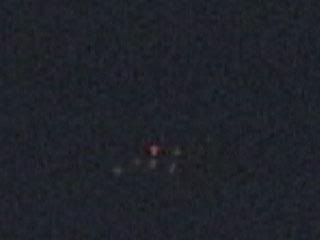
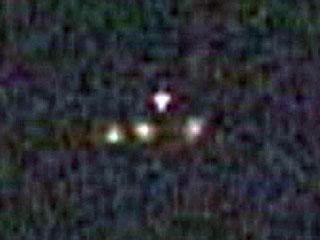
source....
News10 often receives calls from those who spotted something unusual in the night skies. It's not nearly as common for those calls to be backed up by our own Air10.
While shooting Friday Night Football highlights over Sacramento, Air10 pilot Ed Georges and FNF correspondent Angel Cardenas spotted a strange set of lights flying over their helicopter.
"I know what aircraft lighting looks like and this was definitely something different," Georges said. "It looked almost like a scrolling message on a blimp to the naked eye. I was at 1,200 feet and it was considerably higher."
Georges said he and Cardenas manuevered the helicopter to get a better look at the lights through Air10's Power Zoom camera.
"(Angel and I) were both amazed at the odd lights and movement. I started flying toward it, but it began to fade away and disappeared to the southeast," Georges said. "Not knowing the size of the object, I couldn't determine how far away we were, but I believe it was some distance away as the image was fuzzy even through the PowerZoom camera."
Not long after their sighting, several callers phoned the News10 newsroom to report seeing the same phenomenon.
When contacted, Federal Aviation Adminstration and Sacramento International Airport spokespeople said they hadn't heard anything about the object and had no idea what the craft could be. A Travis Air Force Base representative said the base had no aircrafts that could be confused with a UFO.
So what is it?


source....
Wednesday, December 10, 2008
Everyone is in a hurry to scream "racism" these
days!
"In what aisle could I find the Polish sausage?"
The clerk looks at him and says, "Are you
Polish?"
The guy (clearly offended) says, "Well, yes I am. But
let me ask you something.
If I had asked for Italian sausage would you ask me if I
was Italian?
Or if I had asked for German bratwurst, would you ask me if
I was German?
Or if I asked for a kosher hot dog would you ask me if I
was Jewish?
Or if I had asked for a Taco would you ask if I was
Mexican? Would you? Would you?"
The clerk says, "Well, no!"
"If I asked for some Irish whiskey, would you ask if I
was Irish?"
"Well, I probably wouldn't!"
With deep self-righteous indignation, the guy says,
"Well then, why did you ask me if I'm Polish
because I asked for Polish sausage?"
The clerk replies, "Because you're in Home
Depot."
Thanks Dale!
- Quads, hailing from Grand Marsh Observatory atop Elk Castle Hill!
days!
"In what aisle could I find the Polish sausage?"
The clerk looks at him and says, "Are you
Polish?"
The guy (clearly offended) says, "Well, yes I am. But
let me ask you something.
If I had asked for Italian sausage would you ask me if I
was Italian?
Or if I had asked for German bratwurst, would you ask me if
I was German?
Or if I asked for a kosher hot dog would you ask me if I
was Jewish?
Or if I had asked for a Taco would you ask if I was
Mexican? Would you? Would you?"
The clerk says, "Well, no!"
"If I asked for some Irish whiskey, would you ask if I
was Irish?"
"Well, I probably wouldn't!"
With deep self-righteous indignation, the guy says,
"Well then, why did you ask me if I'm Polish
because I asked for Polish sausage?"
The clerk replies, "Because you're in Home
Depot."
Thanks Dale!
- Quads, hailing from Grand Marsh Observatory atop Elk Castle Hill!
Tuesday, December 9, 2008
Too much snow already!
There's 12-14 inches of snow in the woods now. I was able to break trail with my little Polaris Hawkeye, just barely, but I can't imagine being able to pull a load of wood with it. Looks like I won't be able to cut any wood again this winter, just like last winter. It's not an emergency, I have plenty, but if this continues for many more years it might become an emergency!
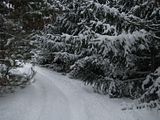
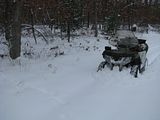
- Quads, hailing from Grand Marsh Observatory atop Elk Castle Hill!
There's 12-14 inches of snow in the woods now. I was able to break trail with my little Polaris Hawkeye, just barely, but I can't imagine being able to pull a load of wood with it. Looks like I won't be able to cut any wood again this winter, just like last winter. It's not an emergency, I have plenty, but if this continues for many more years it might become an emergency!


- Quads, hailing from Grand Marsh Observatory atop Elk Castle Hill!
Here we go again!
It's starting to look a lot like last year. We got almost 10 inches of snow so far, and still snowing hard at 9:00am. Although, on the radar it looks like it's almost done.
We made it home ok from Medford last night after Mrs. Reverend's grandma's funeral (130 miles one-way). It snowed really hard in Spencer, for a few miles, then it quit until Necedah. From Necedah it snowed hard all the way and by the time we got to Grand Marsh there was already a couple inches of new snow.
New washing machine still working good this morning.
I've taken almost 7,000 pictures with my Canon SX100 IS camera after owning it for 9 months. That's already getting close to the number of pictures I took with the old Sony Mavica in 8 years (10,000). The night sky pictures that I take with the SX100 really add up though, since it takes so many to make one. Something I couldn't do with the old Mavica. The Sanyo is a good camera too, but not in the same class as the Canon. My daughter sort of claimed the Sanyo for herself so I don't get to use it much anymore. Same story with the Panasonic, the only difference being that Mrs. Reverend claimed that one! If I buy anymore cameras in the future, they'll be Canons. I'm sold on those.

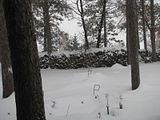
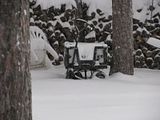
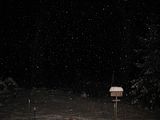
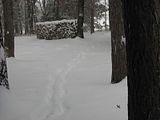
- Quads, hailing from Grand Marsh Observatory atop Elk Castle Hill!
It's starting to look a lot like last year. We got almost 10 inches of snow so far, and still snowing hard at 9:00am. Although, on the radar it looks like it's almost done.
We made it home ok from Medford last night after Mrs. Reverend's grandma's funeral (130 miles one-way). It snowed really hard in Spencer, for a few miles, then it quit until Necedah. From Necedah it snowed hard all the way and by the time we got to Grand Marsh there was already a couple inches of new snow.
New washing machine still working good this morning.
I've taken almost 7,000 pictures with my Canon SX100 IS camera after owning it for 9 months. That's already getting close to the number of pictures I took with the old Sony Mavica in 8 years (10,000). The night sky pictures that I take with the SX100 really add up though, since it takes so many to make one. Something I couldn't do with the old Mavica. The Sanyo is a good camera too, but not in the same class as the Canon. My daughter sort of claimed the Sanyo for herself so I don't get to use it much anymore. Same story with the Panasonic, the only difference being that Mrs. Reverend claimed that one! If I buy anymore cameras in the future, they'll be Canons. I'm sold on those.





- Quads, hailing from Grand Marsh Observatory atop Elk Castle Hill!
Guangdong's eight-toed wonder

Two new parents from Leizhou, Guangdong got a bit of a surprise last week when they discovered that their newborn baby boy had eight toes on each foot. The baby has the usual number of fingers (ten in total), but oddly enough, no thumbs at all. Doctors say the birth anomaly could have been caused by either genetics or environmental pollution.
source....

Two new parents from Leizhou, Guangdong got a bit of a surprise last week when they discovered that their newborn baby boy had eight toes on each foot. The baby has the usual number of fingers (ten in total), but oddly enough, no thumbs at all. Doctors say the birth anomaly could have been caused by either genetics or environmental pollution.
source....
Monday, December 8, 2008
A miracle pup clung to a speeding car for more than 15 miles after being knocked down.

The motorist, Marco Menozzi, didn't even stop when he mowed down the one-year-old pooch while doing 70mph on a side road in Cozze, southern Italy.
But he hit the dog so hard he was embedded in the grill under the bonnet of the Peugeot 207 and managed to cling on until the car eventually stopped.
Vets have treated the stray for a broken leg and bruising and he's now in a police pound looking for new owner.
"He's a very lucky boy. He was saved because he was hit so hard. Any softer and he would have bounced off the car and been crushed under the wheels," said a police spokesman.
source....

The motorist, Marco Menozzi, didn't even stop when he mowed down the one-year-old pooch while doing 70mph on a side road in Cozze, southern Italy.
But he hit the dog so hard he was embedded in the grill under the bonnet of the Peugeot 207 and managed to cling on until the car eventually stopped.
Vets have treated the stray for a broken leg and bruising and he's now in a police pound looking for new owner.
"He's a very lucky boy. He was saved because he was hit so hard. Any softer and he would have bounced off the car and been crushed under the wheels," said a police spokesman.
source....
Subscribe to:
Posts (Atom)
